






























The Electric Cooperatives of Mississippi Foundation was created by the Electric Cooperatives of Mississippi in 2005 in an e ort to give back to the communities they serve by providing scholarships for engineering students in their junior or senior year of college.
This year, five college students were awarded $2,000 scholarships. Arden Armstrong of Jackson, an electrical engineering major at Mississippi State University; Chris Pope of Leaksville, an electrical engineering student at Mississippi State University; Shay Ramsey of Biloxi, a mechanical engineering major at Mississippi State University; Garrett Minchew of Laurel, a mechanical engineering major at Mississippi State University; and John Alliston of Gulfport, an electrical engineering major at Mississippi State University won the scholarships. Armstrong, Pope, Ramsay, and Minchew are working for Cooperative Energy, while Alliston works at Coast Electric. The students work at the electric cooperatives as part of Mississippi State University’s Co-op engineering program.









U.S. Senator Cindy Hyde-Smith (R-Miss.) recently supported committee approval of a far-reaching bill to strengthen American energy security by reforming the federal permitting process for critical energy and mineral projects in the U.S., according to a news release.
Hyde-Smith serves on the Senate Energy and Natural Resources Committee that marked up the bipartisan Energy Permitting Reform Act of 2024, a measure that would expedite permitting decisions and review of legal challenges to energy, mineral, and electricity production and distribution projects. It was approved 15 to 4.
“The reforms in this legislation are overdue. The citizens of this country and my state will be better o by cutting red tape in the permitting process, providing greater stability in oil and gas production, and enhance energy security overall. That said, I think the bill can still be improved,” Hyde-Smith said.
Of interest to Mississippi, the measure would mandate increased o shore oil and gas lease sales in the Gulf of Mexico, permanently end the Biden administration’s so-called pause on liquified natural gas (LNG) exports, and expedite judicial reviews of federal energy and mineral project authorizations.
Hyde-Smith, in a statement for the record, indicated the need to address concerns raised by electric cooperatives in Mississippi regarding interstate electric transmission reform, specifically citing a state law enacted last year to maintain state jurisdiction over the integrity of electric transmission infrastructure.
“I want to make sure that the voices of our electric cooperatives are being heard, too. Co-ops in Mississippi have raised concerns regarding the changes to Section 401 in this bill, specifically regulatory overreach, cost allocation, and state authority,” Hyde-Smith said.
“We have to be aware of the potential setback the Energy Permitting Bill Act could cause for my state’s control of new transmission projects if FERC’s authority can supersede these state regulations. So as this measure continues to move through the legislative process, I want to ensure that our co-ops are being heard and that their concerns are being addressed,” she said. “We can’t leave our electric cooperatives out of the conversation.”
Energy and Natural Resources Committee Chairman Joe Manchin (I-W.Va.) and Ranking Member John Barrasso (R-Wyo.), who negotiated the legislation, indicated a willingness to work with committee members to address a variety of remaining concerns with the bill, which could be considered by the full Senate later this year.



“Improving the quality of life for all those we touch.”
With severe weather events occurring more frequently, it makes sense to be prepared. During a prolonged power outage or other emergency, this means having enough food, water, and supplies to last at least a few days.
In honor of National Preparedness Month in September, I want to remind members of our community about the power of preparation. While you don’t have to achieve a “doomsday prepper” level of preparedness, there are several practical steps you can take to keep you and your family safe.
Even at a modest level, preparation can help reduce stress, anxiety and lessen the impact of an emergency event. We recommend starting with the basics.
Here are general guidelines recommended by the Federal Emergency Management Agency:
• Assemble a grab-and-go disaster kit. Include items like nonperishable food, water (one gallon per person, per day), diapers, batteries, flashlights, prescription medications, firstaid kit, battery-powered radio, and phone chargers.
• Develop a plan for communicating with family and friends (i.e., via text, social media, third party, etc.).
• Have some extra cash available; during a power outage, electronic card readers and cash machines may not work.
• Store important documents (birth certificates, property deed, etc.) in a safe place.
• Keep neighbors and coworkers apprised of your emergency plans.
• Fill your car with gas.
• Organize your supplies so they are together in an easily accessible location that family members know about.
If you have older family members or those with special needs, make sure they have enough medication and supplies for a few days. In case of prolonged and/or unavoidable outages, make plans ahead of time for those individuals who rely on electricity for medical devices. If they don’t live with you, arrange for a neighbor to check in on them. If a severe weather event is expected, consider having your relative stay with you if feasible, otherwise call them daily. If you have an infant or young children, make certain that you have ample formula, diapers, medication, and other supplies on hand to weather an outage lasting several days or more.
At 4-County, we care about your safety. Planning for an emergency situation today can give you more confidence to deal with severe weather and potential outages in the future.

by Brian Clark
CEO/General Manager
With the Tennessee Valley Authority expected to announce a rate increase later this month, 4-County is also likely looking at a slight rate increase of its own.
“For years, we have done everything we can to avoid this,” 4-County CEO Brian Clark said. “We have been fiscally responsible enough to not have had an overall 4-County rate increase in 10 years. We even absorbed a 1.5% rate increase from TVA in 2016 that typically would have been passed through to you, the ratepayer. But the time may have finally come where all the e ciencies and prudent financial decisions can’t keep up with inflation. I promise you that if we enact an increase, we will continue to work diligently to minimize its impact on you; we will continue to find ways to increase e ciencies, and we will continue to work to try and avoid future increases.”
Here are four items discussed when a rate adjustment may be necessary.
1. A cooperative’s rate structure should be designed to collect adequate revenue from the members who use the electricity. The costs of providing electric service range from highly-variable generating fuel expenses (in our case, rising costs to purchase power from the Tennessee Valley Authority) to plant expenses, as well as margins to finance infrastructure and its upgrades.
2. Total cooperative revenues should be sensitive to changes in expense drivers.
3. A cooperative should motivate its members to use electricity and resources wisely, which will help reduce current and future costs. 4-County o ers a wide variety of energy e ciency tips and programs to members.
4. Electric rates should be revised as needed in order to address changing revenue requirements.
4-County has, and will, do everything possible to keep your rates and service at a high standard. We will keep you up to date on rate adjustment discussions. For more information, call 1-800-431-1544.













Let’s be honest. It’s hard to play tennis in a parking lot. The surface is uneven. The ball bounces are never true. You may slip on the gravel. And even the best players must be concerned about hitting cars.
Members of last year’s Noxubee County High School (NCHS) tennis team can tell you all about it. Without courts to practice on, the team purchased a portable net and practiced in the school parking lot – near the hill where the balls almost never stop rolling.
“It was di cult for us to practice,” said Lakayria Dupree, a senior and four-year member of the team.
Noxubee County High School (NCHS) Head Tennis Coach John Kitele agreed. “Of course, there were no lines or markings in the parking lot. We were operating without much practice, and we had to play all our matches away,” he explained.
But now — thanks in part to multiple grants (totaling $20,000) over a 2-year period from the 4-County Foundation — the team has a place to play. The City of Macon is allowing the team (and all its citizens) to play on its courts, but the location needed some substantial repairs. Monies raised (about $77,600) were used to re-surface and re-paint four hard courts. The facelift also included new nets and posts.



The court repairs will help educate area folks about the great sport of tennis, Kitele added. “This e ort will raise the profile of tennis in our community and at our school. This sport doesn’t get the same notoriety here as football or basketball.”
Kitele and Dupree said they are thankful for the support from project donors. “Without that help, none of this would have been possible,” Kitele stressed, “and these kids wouldn’t have anywhere to play.”
Dupree is excited about her senior year in school and on the court. “This is my last season. I want to make it count.”
We’re the sports team that people have heard about, but never seen.
— John Kitele —
The project, a vision of the Macon Dreams Come True Foundation (MDCTF), received additional support and donations from the Macon Rotary Club, Noxubee County Tax Assessor Valerie Harris, Senter Hardware, Conner’s Sweets, the NCHS Alumni Association, school fundraisers, and anonymous donors from around the country, MDCTF o cials said.
“We’re the sports team that people have heard about, but never seen,” Kitele explained. “A lot of parents haven’t been able to travel to see their kids play. Now they can support their kids in person.”
4-County believes in helping the communities it serves. That’s why the cooperative launched the 4-County Foundation, a community service program. Since its inception, 4-County members’ utility bills have been rounded up to the nearest dollar: a $125.79 bill, for example, becomes $126. Now, at the most, that’s around a little less than an extra $12 per year per member (an average of about $5.50 per year per member). However, when you multiply those contributions by thousands of member participants, that change becomes real dollars of hope and assistance for those worthy Foundation recipients.
4-County Foundation Board members (individuals selected from throughout the cooperative service area) decide and handle fund requests.
Applications to receive Foundation assistance for individuals and organizations are available in 4-County o ces and on the 4-County website, www.4county.org. You can also call 1-800-431-1544 for more information. Ninetythree percent of 4-County members participate.
















Betty Sue served in a variety of Member Service roles in her career. Enjoy Your Retirement!

Mary Margaret Swain

Mary Margaret Swain has joined the 4-County/FASTnet team as an Accountant. Mary Margaret and her children, Ridge, 9, and Ryland, 2, live in Steens.
She is a graduate of Mississippi University for Women with a bachelor’s degree in accounting. And she has her master’s degree from the University of Alabama at Birmingham.
Prior to 4-County, she worked for area accounting firms. Her hobbies include baking and playing softball.
Welcome to the 4-County/FASTnet team, Mary Margaret!




As a youth, the Starkville native lived a few years in Canada with his mom and siblings. “The people there had some di erent accents. But they were a lot like Americans,” Tre said with a laugh.
During his short stint with our neighbors to the north, he did learn a few things that most people in Mississippi don’t know. “I learned how to play hockey and lacrosse,” Tre said. “Their football fields are a di erent size, too. And they like gravy on their French fries.”
Noting that living in Canada was a good experience, Tre said he was glad to move back to Starkville – where his roots are, and the football fields are the right size. “I’m a country boy through and through. Most of my life I grew up playing ball in the yard and riding horses on my uncle’s farm,” he added.
Today, Tre and his wife, Jessica, live in Oktibbeha County. They attend Ebeneezer Baptist Church. In his spare time, Tre enjoys sitting on the porch, riding four wheelers, grilling, shooting basketball, and playing NCAA football on the Playstation 5. He is looking forward to having a vegetable garden.

Tre joined the 4-County/FASTnet team in 2022 as a Fiber Install Technician. He has advanced to the role of Fiber Optics Voice Data Specialist. Prior to working for FASTnet, Tre served eight years as a wire technician and in sales for AT&T. He also had a brief stint with 3M Company in Guin, Alabama.
Tre is a graduate of East Mississippi Community College’s Electronics Technology and Automation and Control Technology Programs.
He enjoys the challenges of the broadband fiber industry. “It keeps you wanting to learn more, being part of this evolving technology. I always want to master my craft,” Tre explained. “It’s amazing how such a small piece of wire can pack such a big punch.” Tre also appreciates the opportunities to work with customers and travel throughout FASTnet’s service area. “We have a close-knit group of employees, a home away from home.”
There’s something special in the air at 4-County/FASTnet, Tre said. “It makes me feel blessed that I’m part of 4-County and FASTnet,” he stressed. “This place is di erent, a professional organization that cares.”



























































What is automated meter reading (AMR)?
Automated meter reading (AMR) systems use a digital meter to send meter reading data remotely, eliminating the need to read meters manually.
Why is Central Electric installing AMR?
Benefits to utilizing the cellular AMR system includes saving money on meter readings, e cient power outage response, and easier diagnosis of high energy bills. As we enhance the system, more benefits will become available to our members.
When will AMR happen?
The project is expected to begin in early 2025.
Who will be changing the meters?
We will utilize contractors to install the meters.
Will I need to upgrade my meter base?
Probably not. The AMR meters fit right into the same meter base as your current meter. But, if our AMR installers discover your meter base is broken or needs maintenance, you’ll need to call a licensed electrician to fix the problem. The meter base at your home or business is part of your electrical system, just like the breaker panel or wiring inside the walls. Central Electric’s service rules require member-owners to provide a suitable meter base and keep it in good working order as a condition of receiving electric service from the cooperative.
Do I have a choice in getting an AMR meter?
No. AMR meters will be installed on all accounts.
How much is AMR going to cost member-owners?
There will be no additional cost to the member-owner to install the AMR system.
What information does the AMR meter report?
The AMR meter reports electric use and power interruption data.
What day of the month will the new meters be read?
The AMR meters will actually report electric use daily.
Will Central Electric still do meter inspections?
Routine inspections of meters will continue, so we can spot safety hazards, maintenance issues, theft, or other problems.
Will the AMR meter notify Central Electric when the power goes out?
Yes, but we still recommend that you report any disruption of service. Our phone numbers are the same: 601-267-5671; 601-625-7422; 601-656-2601; 601-829-1201.
What benefits does the AMR system provide?
Here are the top reasons why AMR is a good move for Central Electric and our members:
· Saves money,
· Reduces visits to your home/property,
· Reduces the potential for misreads and data entry errors,
· Provides easy, quick, inexpensive meter re-reads,
· Enhances accuracy of electric bills,
· Contributes to more e cient outage restoration,
· Enhances troubleshooting service problems,
· Quickly spots meter tampering and energy theft, and
· Allows for additional member services in the future.

















o ers the tools and knowledge that will enable you to sharpen your leadership skills in your classroom, community, church, and family.


Our program is for high school juniors interested in enhancing their leadership skills.

Since 1986, students in Mississippi have competed for the opportunity to participate in this unique leadership program. This program is an educational and fun experience that makes a lasting impact on young people.

The three-day workshop features a true cooperative learning atmosphere. More than 80 students from across the state will experience cooperative team-building exercises, a breakfast with their legislators, a visit to the Capitol, a town hall meeting, and motivational speakers. We will also have time for games and interaction between the students.
You will have the opportunity to earn a $500 or $1,000 scholarship.
The group of young Mississippians participating in the program represent electric cooperatives across the state. Students are selected through various forms of competition conducted by the local cooperatives.
Annually, more than 1,000 young people are involved in the program selection process statewide.
Each year, Mississippi’s student delegation joins more than 1,659 high school juniors from 44 states across the nation at the Electric Cooperative Youth Tour in Washington, D.C., where they learn about cooperatives and rural electrification from a national perspective.
The Youth Tour is a wonderful sightseeing experience that also o ers an opportunity for making new friends.
The Youth Tour is organized by the Electric Cooperatives of Mississippi (ECM) and the National Rural Electric Cooperative Association (NRECA).
Students’ expenses for both events are funded entirely by Central Electric. There are no hidden costs; Central Electric pays for all travel, lodging, meals, educational materials, and admission fees. Our support of the program demonstrates a commitment to our young people and a desire to provide an e ective, high-quality leadership program to help prepare them for life’s challenges.
Central Electric’s Cooperative Youth Leaders program director will contact an o cial at each of our local schools and provide program details. If you are interested in being a representative, contact your school guidance counselor or fill out and return the application on the following page.
(Please limit your information to this sheet)
Are you currently a high school junior and your parent(s) or legal guardian receives electric service from Central Electric Power Association? If so, you are eligible to apply to represent Central Electric Power Association in the Cooperative Leaders Workshop February 26-28, 2025, and the NRECA Youth Tour of Washington, D.C. June 14-20, 2025.
1. Applicant must be a high school junior (11th grade) whose parent(s) or legal guardian(s) receives electric service from Central Electric Power Association.
2. The top applicants will be selected by an independent panel of judges to participate in an interview process. Following the interview process, winners will be selected to represent Central Electric Power Association in the Cooperative Leaders Workshop in Jackson and the NRECA Youth Tour of Washington, D.C.
3. If selected, student must commit to attend both the Cooperative Leaders Workshop February 26-28, 2025, in Jackson, MS and the NRECA Youth Tour, June 14-20, 2025, in Washington, D.C.
4. Application must be filled out by the student and postmarked by Wednesday, September 11, 2024. Please email your application to jcpatterson@centralepa.com or mail to:
Cooperative Youth Leaders
Attn: Jessica Patterson
Central Electric Power Association
Post Office Box 477 Carthage, MS 39051
Student’s full name
Name student goes by
Student’s mailing address
Student’s 911 address
Parent(s) or legal guardian
Name Central EPA bill is listed in
Account number
Daytime phone number
Alternate number
Email address
School
Student’s t-shirt size
Student signature
Parent/legal guardian signature
Please list any school and community activities/memberships and leadership positions:
Please list any awards or special recognition:
What are your college and career goals?
What are two characteristics of a good leader and why?
What is an interesting fact about yourself?
This institution is an equal opportunity provider and employer
Please contact Central Electric’s youth leadership program coordinator if you have any questions. Jessica Patterson, program director 601-267-5671 • jcpatterson@centralepa.com
Like our Electric Cooperatives of Mississippi Cooperative Youth Leaders page www.facebook.com/ECMCYL and follow us on Instagram @msyouthleaders.












































by Miranda Boutelle
QHow do I use federal tax credits and rebates to upgrade my home?
ATax credits and rebates can help bridge the a ordability gap to higher e ciency equipment for your home, allowing you to complete energy e ciency upgrades that can lower your energy use and save you money in years to come.
First, knowing the di erence between a tax credit and a rebate is important. A rebate is a payment for purchasing or installing a qualified product or home improvement. Depending on how the rebate program is set up, it may be provided at the time of purchase or applied for and received after installation. Check with your electric cooperative to see if they o er rebates. Typically, the rebate is applied as a credit on your electric bill. In some cases, the rebate is provided as a cash payment to those who complete eligible projects.
A tax credit is a dollar-for-dollar amount that taxpayers can report on their tax documents to reduce the amount of taxes owed. You apply for a tax credit when you file your tax documents, so it typically takes longer to reap the benefits than it does with a rebate.
According to ENERGY STAR®, homeowners can qualify for up to $3,200 annually in federal tax credits for energy e ciency upgrades. Federal tax credits are available for heating and cooling system upgrades, including heat pumps, furnaces, central air conditioners, boilers, and geothermal heat pumps. Tax credits for ENERGY STAR®-rated heat pump water heaters cover 30% of the project cost, up to $2,000. You can also improve your home’s envelope — the portion of the home that separates the inside from the outside — with tax credits for insulation, windows and skylights.
If an energy e ciency upgrade requires improving the electrical panel in your home, there’s a tax credit for that, too. You can receive 30% of the cost of the panel upgrade, up to $600.
These federal tax credits are available through 2032. You must own the home you’re upgrading, and it must be your primary residence. Federal tax credits only apply to existing homes in the United States, not new construction.
The Inflation Reduction Act of 2022 expanded available funding for many home upgrades. The act allocated $8.8 million for home rebate programs to be implemented at the state level, and this funding is o ered in two di erent programs. The HOMES program allows up to $8,000 per home for standard-income households. Higher rebates are available for low- to moderate-income households. The HEAR program o ers rebates of up to $14,000 per home for qualified, e cient electric equipment for low- to moderate-income households.
These programs are designed to bolster existing programs and should be available in late 2024 or early 2025. Check with your electric cooperative or state o ce to find out if they are being o ered in your state.

When shopping for appliances, look for the ENERGY STAR® logo on the energy guide to identify which products are the most e cient options.

Tax credits for ENERGY STAR® heat pump water heaters cover 30% of the project cost, up to $2,000.
Additional energy e ciency rebates might also be available. More than half of U.S. states require energy e ciency programs for residents, according to the American Council for an EnergyE cient Economy. These programs can help people save money on their electric bills and help states meet climate goals, reduce system costs, and improve the electric grid.
I have had the privilege of working in energy e ciency rebate programs for many years and have seen the benefits of these programs firsthand. Tax credit and rebate programs can make upgrades more a ordable — helping people save money and improve the overall comfort of their homes.
Miranda Boutelle is the chief operating o cer at E ciency Services Group in Oregon, a cooperatively owned energy e ciency company.







































by Qua’Shara Monix





















It’s September, which means a new school year. We also have a 2024 presidential election coming up a couple of months later. Last year my prayer was about back to school safety and mental well-being for our children, parents, teachers, and sta . This year, I want to convey the same prayer coupled with a twist. I anticipate you guys will join in to pray for this election and the candidates looking to serve our country. I pray they seek God first or be encouraged by the people around them who exemplify good ideas, beliefs, and comprehension. Give them the strength to make quality decisions both in and out of the public eye. I pray they look to better understand the situations and concerns that confront our city, our state, and our country.




























Every vote counts, and it’s important for us to exercise our right to vote and have our voice heard on the issues that matter the most. Each vote cast is a testament to the struggles of those who came before us, a tribute to their sacrifices, and a promise to uphold the principles of democracy. Voting is important in shaping us to be an upstanding and ethical member of society. Your vote will help decide the future of health care, immigration reform, economic policy, women’s health, social programs, and foreign aid. As our elected representatives, politicians are supposed to reflect our values. However, even though the election divides us as via political preferences, remember God purposely created us with di erences and designed us to work together.
“Just as a body, though one, has many parts, but all it’s many parts form one body, so it is with Christ” (1 Corinthians 12:12).


In Jesus’ name,
Amen






Our leaders have di erent opinions and priorities. Pray that their minds, thoughts, and body will be guided so they may use the knowledge gained and wisdom to navigate di erences and work together to strengthen our country and build a kingdom. Let’s vote for our children and to protect their future. We have the power to make key decisions about the quality of life we want for ourselves, our families, and our communities. May there be a new and state-of-the-art development of alliance, cooperation, and respect in our nation’s capital and throughout the country.

























CEPA will host a National Voter Registration Day Drive at Coahoma Community College, 3240 Friars Point Rd. in Clarksdale on Sept. 17, 2024, from 11 a.m. to 2 p.m.











































For the foreseeable future, electric co-ops will continue to face challenges in securing the supplies and equipment they need.
by Scott Flood




From grocery store shelves to repair parts for vehicles, we’ve all had firsthand experiences with supply chain issues in recent years. So much so that the supply chain has become a convenient scapegoat anytime a business falls short of our expectations. But when it comes to your local electric cooperative, supply chain challenges are very real and often troubling.
Parts and components electric co-ops use every day are in short supply, which delays planned upgrades for power reliability and increases the costs of parts and labor.
Electric co-ops are working together to find innovative ways to deal with supply chain issues. This year, those e orts resulted in a major win regarding updated federal e ciency standards for distribution transformers that has co-op leaders breathing more easily.
Electric transformers are critical pieces of equipment that help deliver power to consumers. These essential devices adjust electricity voltage, either up or down, to enable safe and e cient power flow.
Late in 2022, the Department of Energy (DOE) proposed new e ciency requirements for the distribution transformers that deliver power to every home, school, and business in America. Among other provisions, the proposal would have required manufacturers of those transformers switch to amorphous steel within three years, in place of the grain oriented electrical steel (GOES) that has long been used. Amorphous steel is chemically altered in ways that may make transformers more e cient.
The National Rural Electric Cooperative Association (NRECA), the national trade association that represents more than 900 co-ops, is wary of DOE’s expectations for this change in material, and especially at a time when transformer manufacturers are already struggling to keep up with demand. Currently, there is only one U.S. producer of this specialty steel.
The availability of federal infrastructure funding is making it possible for co-ops to invest in the capacity, safety, and reliability of the systems delivering electricity to co-op communities. That’s a good thing for coops and their members, but it’s increasing pressure on the supply chain.
“The domestic supply chain hasn’t caught up with demand, and the industry is going through a learning curve,” notes Stephanie Crawford, NRECA regulatory a airs director. “It’s going to take some time for manufacturers to retool their production and producers to make enough amorphous steel to meet the need.”
While co-op leaders appreciate the significant amount of federal money being made available to update local energy infrastructure, that’s also putting the squeeze on supply.
Everyone across the country is making these investments at the same time, creating demand not just for new transformers, but for all the basic materials and equipment cooperatives need.
“Everyone across the country is making these investments at the same time, creating demand not just for new transformers, but for all the basic materials and equipment cooperatives need,” Crawford adds. “Amid all the challenges co-ops are already facing, it presents a big problem to ask the industry to make a 100% switch in just three years when the sole supplier only produces enough for about 5% of today’s market.”
NRECA and electric co-ops joined others in the power industry to educate key contacts in Congress, the White House, and DOE about supply chain challenges, particularly the requirements for the quick shift to amorphous steel.


“After more than a year of advocacy e orts, the DOE issued its final rule, which allows continued use of GOES in smaller-sized transformers,” Crawford explains. “This provides greater certainty with the transformer sizes cooperatives use the most, particularly in the residential segment.”
The DOE rule also includes a longer compliance timeframe for shifting to amorphous steel.
“Extending the deadline to 2029 will help manufacturers adapt for the future,” Crawford said. “The extension allows transformer manufacturers more time to adjust to the new standard and focus on output that electric cooperatives need.”
For the foreseeable future, electric co-ops will continue to face challenges in securing the supplies and equipment they need. The good news is that most have initiated processes to mitigate and manage those risks, so they can continue to meet their members’ needs. While the future availability of larger transformers remains a cause for concern, co-ops are pleased to see investments in U.S. manufacturing facilities, and that’s a hopeful sign.





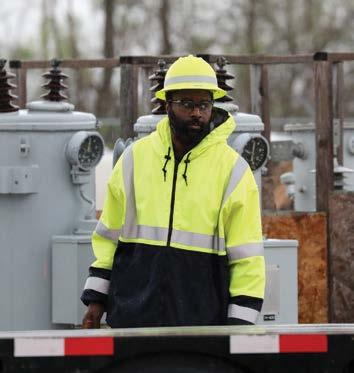


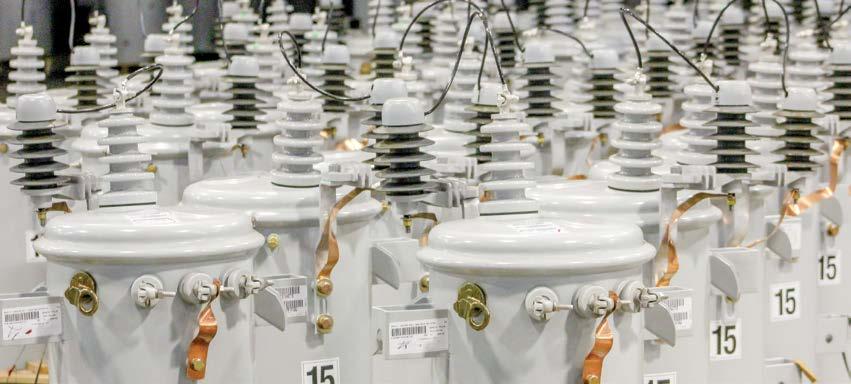
For more than four decades, business writer Scott Flood has worked with electric cooperatives to build knowledge of energy-related issues among directors, sta , and members.












































by Miranda Boutelle
QHow do I use federal tax credits and rebates to upgrade my home?
ATax credits and rebates can help bridge the a ordability gap to higher e ciency equipment for your home, allowing you to complete energy e ciency upgrades that can lower your energy use and save you money in years to come.
First, knowing the di erence between a tax credit and a rebate is important. A rebate is a payment for purchasing or installing a qualified product or home improvement. Depending on how the rebate program is set up, it may be provided at the time of purchase or applied for and received after installation. Check with your electric cooperative to see if they o er rebates. Typically, the rebate is applied as a credit on your electric bill. In some cases, the rebate is provided as a cash payment to those who complete eligible projects.
A tax credit is a dollar-for-dollar amount that taxpayers can report on their tax documents to reduce the amount of taxes owed. You apply for a tax credit when you file your tax documents, so it typically takes longer to reap the benefits than it does with a rebate.
According to ENERGY STAR®, homeowners can qualify for up to $3,200 annually in federal tax credits for energy e ciency upgrades. Federal tax credits are available for heating and cooling system upgrades, including heat pumps, furnaces, central air conditioners, boilers, and geothermal heat pumps. Tax credits for ENERGY STAR®-rated heat pump water heaters cover 30% of the project cost, up to $2,000. You can also improve your home’s envelope — the portion of the home that separates the inside from the outside — with tax credits for insulation, windows and skylights.
If an energy e ciency upgrade requires improving the electrical panel in your home, there’s a tax credit for that, too. You can receive 30% of the cost of the panel upgrade, up to $600.
These federal tax credits are available through 2032. You must own the home you’re upgrading, and it must be your primary residence. Federal tax credits only apply to existing homes in the United States, not new construction.
The Inflation Reduction Act of 2022 expanded available funding for many home upgrades. The act allocated $8.8 million for home rebate programs to be implemented at the state level, and this funding is o ered in two di erent programs. The HOMES program allows up to $8,000 per home for standard-income households. Higher rebates are available for low- to moderate-income households. The HEAR program o ers rebates of up to $14,000 per home for qualified, e cient electric equipment for low- to moderate-income households.
These programs are designed to bolster existing programs and should be available in late 2024 or early 2025. Check with your electric cooperative or state o ce to find out if they are being o ered in your state.

When shopping for appliances, look for the ENERGY STAR® logo on the energy guide to identify which products are the most e cient options.

Tax credits for ENERGY STAR® heat pump water heaters cover 30% of the project cost, up to $2,000.
Additional energy e ciency rebates might also be available. More than half of U.S. states require energy e ciency programs for residents, according to the American Council for an EnergyE cient Economy. These programs can help people save money on their electric bills and help states meet climate goals, reduce system costs, and improve the electric grid.
I have had the privilege of working in energy e ciency rebate programs for many years and have seen the benefits of these programs firsthand. Tax credit and rebate programs can make upgrades more a ordable — helping people save money and improve the overall comfort of their homes.
Miranda Boutelle is the chief operating o cer at E ciency Services Group in Oregon, a cooperatively owned energy e ciency company.













Where our members have











Registration for our 2024 Annual Meeting and Member Appreciation Night is in full swing and open until 10 a.m. on Oct. 31. As a co-op member, one of the most important things you can do is to be part of our Annual Meeting process. It allows you to have a voice in board leadership, which is something most businesses don’t o er. Because co-ops like Coast Electric are owned and led by the people we serve, board members are also co-op members and receive the same service you do. This allows board members to have insight into what it’s like to be a Coast Electric member and helps them make the best decisions on your behalf.
We hope you will be able to join us at the meeting on Nov. 7, but we understand that you might not be able to make it. If you can’t join us in person, you can always register your proxy at any of our o ces, online at www.coastelectric.coop or by mailing in the card that we sent out in late July. Everyone who registers or attends will have the opportunity to win up to $1,000 in electricity credits,
which is something we know our members could use after a hot summer with increased energy use.
Increased energy use means higher bills, and we know that can create a strain on your finances. If you need help paying your bill, remember that Catholic Charities can help through Operation Round Up. We provide funds monthly to the Share Your Blessings Fund. If you need help, don’t hesitate to reach out. Share Your Blessings exists so we can help our neighbors in times of need.

by Ron Barnes
President and CEO



Attend the Annual Meeting on Nov. 7 or register your proxy by 10 a.m., Oct. 31, for a chance to win up to $1,000 in electricity credits!
• Visit www.coastelectric.coop/annual-meeting-registration
• Review candidate bios and meeting information
• Click “Register your proxy”
• Enter your member number (numbers before the dash only)
• Enter your five-digit billing zip code
• Click “Go”
• Follow the instructions


Share Your Blessings can help. Temperatures have been soaring this summer. High temperatures mean increased energy use and higher bills. We understand that high bills are a burden for our members and that everyone needs a little help from time to time. Coast Electric’s Share Your Blessings fund is available to Coast Electric members through Catholic Charities. The fund is financed by contributions to the Operation Round Up program. Funds are distributed based on need, not religious a liation. If you need assistance, please call 855-847-0555 to see if you qualify.
Now is the time to schedule annual maintenance for your home’s heating system. During fall months, HVAC technicians are typically less busy, making this an excellent time for maintenance and any necessary repairs before the winter months. A qualified technician can clean filters, check for leaks and ensure all system components are working e ciently to keep your home cozy and warm when the temperatures begin to drop.

Check the @coastelectric Facebook page for details!
Coast Electric wants you to reduce your energy use and see savings on your monthly energy costs. Each month, you will have an opportunity to register to win a prize that will help you reduce energy consumption in your home.
Congratulations to Ronald Garcia, the winner of our July Reduce Your Use prize.
Visit www.coastelectric.coop and fill out our entry form. It only takes a few seconds, and you could win a prize that helps you save!


























by Scott Flood
From grocery store shelves to repair parts for vehicles, we’ve all had firsthand experiences with supply chain issues in recent years. So much so that the supply chain has become a convenient scapegoat anytime a business falls short of our expectations. But when it comes to your local electric cooperative, supply chain challenges are very real and often troubling.
Parts and components electric co-ops use every day are in short supply, which delays planned upgrades for power reliability and increases the costs of parts and labor.
Electric co-ops are working together to find innovative ways to deal with supply chain issues. This year, those e orts resulted in a major win regarding updated federal e ciency standards for distribution transformers that has co-op leaders breathing more easily.
Electric transformers are critical pieces of equipment that help deliver power to consumers. These essential devices adjust electricity voltage, either up or down, to enable safe and e cient power flow.
a time when transformer manufacturers are already struggling to keep up with demand. Currently, there is only one U.S. producer of this specialty steel.
The availability of federal infrastructure funding is making it possible for co-ops to invest in the capacity, safety, and reliability of the systems delivering electricity to co-op communities. That’s a good thing for coops and their members, but it’s increasing pressure on the supply chain.
“The domestic supply chain hasn’t caught up with demand, and the industry is going through a learning curve,” notes Stephanie Crawford, NRECA regulatory a airs director. “It’s going to take some time for manufacturers to retool their production and producers to make enough amorphous steel to meet the need.”
While co-op leaders appreciate the significant amount of federal money being made available to update local energy infrastructure, that’s also putting the squeeze on supply.






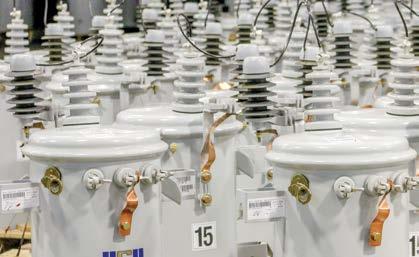
Late in 2022, the Department of Energy (DOE) proposed new e ciency requirements for the distribution transformers that deliver power to every home, school, and business in America. Among other provisions, the proposal would have required manufacturers of those transformers switch to amorphous steel within three years, in place of the grain oriented electrical steel (GOES) that has long been used. Amorphous steel is chemically altered in ways that may make transformers more e cient.
The National Rural Electric Cooperative Association (NRECA), the national trade association that represents more than 900 co-ops, is wary of DOE’s expectations for this change in material, and especially at
“Everyone across the country is making these investments at the same time, creating demand not just for new transformers, but for all the basic materials and equipment cooperatives need,” Crawford adds. “Amid all the challenges co-ops are already facing, it presents a big problem to ask the industry to make a 100% switch in just three years when the sole supplier only produces enough for about 5% of today’s market.”
NRECA and electric co-ops joined others in the power industry to educate key contacts in Congress, the White House, and DOE about supply chain challenges, particularly the requirements for the quick shift to amorphous steel.
“After more than a year of advocacy e orts, the DOE issued its final rule, which allows continued use of GOES in smaller-sized transformers,” Crawford explains. “This provides greater certainty with the transformer sizes cooperatives use the most, particularly in the residential segment.”
The DOE rule also includes a longer compliance timeframe for shifting to amorphous steel.
“Extending the deadline to 2029 will help manufacturers adapt for the future,” Crawford said. “The extension allows transformer manufacturers more time to adjust to the new standard and focus on output that electric cooperatives need.”
For the foreseeable future, electric co-ops will continue to face challenges in securing the supplies and equipment they need. The good news is that most have initiated processes to mitigate and manage those risks, so they can continue to meet their members’ needs. While the future availability of larger transformers remains a cause for concern, co-ops are pleased to see investments in U.S. manufacturing facilities, and that’s a hopeful sign.












































by Miranda Boutelle
QHow do I use federal tax credits and rebates to upgrade my home?
ATax credits and rebates can help bridge the a ordability gap to higher e ciency equipment for your home, allowing you to complete energy e ciency upgrades that can lower your energy use and save you money in years to come.
First, knowing the di erence between a tax credit and a rebate is important. A rebate is a payment for purchasing or installing a qualified product or home improvement. Depending on how the rebate program is set up, it may be provided at the time of purchase or applied for and received after installation. Check with your electric cooperative to see if they o er rebates. Typically, the rebate is applied as a credit on your electric bill. In some cases, the rebate is provided as a cash payment to those who complete eligible projects.
A tax credit is a dollar-for-dollar amount that taxpayers can report on their tax documents to reduce the amount of taxes owed. You apply for a tax credit when you file your tax documents, so it typically takes longer to reap the benefits than it does with a rebate.
According to ENERGY STAR®, homeowners can qualify for up to $3,200 annually in federal tax credits for energy e ciency upgrades. Federal tax credits are available for heating and cooling system upgrades, including heat pumps, furnaces, central air conditioners, boilers, and geothermal heat pumps. Tax credits for ENERGY STAR®-rated heat pump water heaters cover 30% of the project cost, up to $2,000. You can also improve your home’s envelope — the portion of the home that separates the inside from the outside — with tax credits for insulation, windows and skylights.
If an energy e ciency upgrade requires improving the electrical panel in your home, there’s a tax credit for that, too. You can receive 30% of the cost of the panel upgrade, up to $600.
These federal tax credits are available through 2032. You must own the home you’re upgrading, and it must be your primary residence. Federal tax credits only apply to existing homes in the United States, not new construction.
The Inflation Reduction Act of 2022 expanded available funding for many home upgrades. The act allocated $8.8 million for home rebate programs to be implemented at the state level, and this funding is o ered in two di erent programs. The HOMES program allows up to $8,000 per home for standard-income households. Higher rebates are available for low- to moderate-income households. The HEAR program o ers rebates of up to $14,000 per home for qualified, e cient electric equipment for low- to moderate-income households.
These programs are designed to bolster existing programs and should be available in late 2024 or early 2025. Check with your electric cooperative or state o ce to find out if they are being o ered in your state.





Tax
for
cost, up to $2,000.
30% of the
Additional energy e ciency rebates might also be available. More than half of U.S. states require energy e ciency programs for residents, according to the American Council for an EnergyE cient Economy. These programs can help people save money on their electric bills and help states meet climate goals, reduce system costs, and improve the electric grid.
I have had the privilege of working in energy e ciency rebate programs for many years and have seen the benefits of these programs firsthand. Tax credit and rebate programs can make upgrades more a ordable — helping people save money and improve the overall comfort of their homes.
























Modern farming often relies on data and equipment with GPS and auto-guidance systems. Even with these modern conveniences, farm workers must remain vigilant. That’s because farming is considered one of the most dangerous jobs.
Massive machinery is indispensable to farming, but the same impressive size, height, and extensions make them particularly vulnerable to contacting power lines. That’s why staying alert, focused, and knowledgeable about potential hazards and safety procedures is crucial.
During a busy harvest season, the familiar sights around the farm can easily fade into the background, and farm workers can overlook the power lines overhead. However, failing to notice them can lead to deadly accidents.










Awareness of your surroundings, around, above, and below, and planning safe equipment routes can significantly reduce the risk of accidents. Even with GPS and auto-steering, it’s imperative that farm workers keep a close eye on the equipment’s location and are ready to take action if necessary. Exposed underground powerlines, defective wiring in farm buildings, and extension cords are also hazards. Grain bins can pose a potential danger as well. The National Electrical Safety Code requires power lines to be at least 18 feet above the highest point on any grain bin with which portable augers or other portable filling equipment are used. If you plan to install new grain bins or you’re concerned about the proximity of power lines to existing grain bins, contact Delta Electric.















• Exercise caution near power lines. Be careful when raising augers or the bed of grain trucks around power lines.
• Use spotters when operating large machinery near power lines. Ensure the spotters do not touch the machinery while it is moving near power lines.





• Lower equipment extensions, portable augers, or elevators before moving or transporting equipment. Do not raise equipment, such as ladders, poles, or rods into power lines. Remember that non-metallic materials like lumber, tree limbs, ropes, and hay can conduct electricity, especially when damp, dusty, or dirty.
• Never attempt to raise or move power lines to clear a path. Doing so could result in electric shock or death.





• Avoid using metal poles inside bins. Don’t use metal poles to break up bridged grain inside or around bins.
• Hire qualified electricians. Ensure that qualified electricians handle work on drying equipment and other farm electrical systems.




















by Scott Flood




From grocery store shelves to repair parts for vehicles, we’ve all had firsthand experiences with supply chain issues in recent years. So much so that the supply chain has become a convenient scapegoat anytime a business falls short of our expectations. But when it comes to your local electric cooperative, supply chain challenges are very real and often troubling.
Parts and components electric co-ops use every day are in short supply, which delays planned upgrades for power reliability and increases the costs of parts and labor.
Electric co-ops are working together to find innovative ways to deal with supply chain issues. This year, those e orts resulted in a major win regarding updated federal e ciency standards for distribution transformers that has co-op leaders breathing more easily.
Electric transformers are critical pieces of equipment that help deliver power to consumers. These essential devices adjust electricity voltage, either up or down, to enable safe and e cient power flow.
Late in 2022, the Department of Energy (DOE) proposed new e ciency requirements for the distribution transformers that deliver power to every home, school, and business in America. Among other provisions, the proposal would have required manufacturers of those transformers switch to amorphous steel within three years, in place of the grain oriented electrical steel (GOES) that has long been used. Amorphous steel is chemically altered in ways that may make transformers more e cient.
The National Rural Electric Cooperative Association (NRECA), the national trade association that represents more than 900 co-ops, is wary of DOE’s expectations for this change in material, and especially at a time when transformer manufacturers are already struggling to keep up with demand. Currently, there is only one U.S. producer of this specialty steel.
The availability of federal infrastructure funding is making it possible for co-ops to invest in the capacity, safety, and reliability of the systems delivering electricity to co-op communities. That’s a good thing for coops and their members, but it’s increasing pressure on the supply chain.
“The domestic supply chain hasn’t caught up with demand, and the industry is going through a learning curve,” notes Stephanie Crawford, NRECA regulatory a airs director. “It’s going to take some time for manufacturers to retool their production and producers to make enough amorphous steel to meet the need.”
While co-op leaders appreciate the significant amount of federal money being made available to update local energy infrastructure, that’s also putting the squeeze on supply.
Everyone across the country is making these investments at the same time, creating demand not just for new transformers, but for all the basic materials and equipment cooperatives need.
“Everyone across the country is making these investments at the same time, creating demand not just for new transformers, but for all the basic materials and equipment cooperatives need,” Crawford adds. “Amid all the challenges co-ops are already facing, it presents a big problem to ask the industry to make a 100% switch in just three years when the sole supplier only produces enough for about 5% of today’s market.”
NRECA and electric co-ops joined others in the power industry to educate key contacts in Congress, the White House, and DOE about supply chain challenges, particularly the requirements for the quick shift to amorphous steel.


“After more than a year of advocacy e orts, the DOE issued its final rule, which allows continued use of GOES in smaller-sized transformers,” Crawford explains. “This provides greater certainty with the transformer sizes cooperatives use the most, particularly in the residential segment.”
The DOE rule also includes a longer compliance timeframe for shifting to amorphous steel.
“Extending the deadline to 2029 will help manufacturers adapt for the future,” Crawford said. “The extension allows transformer manufacturers more time to adjust to the new standard and focus on output that electric cooperatives need.”
For the foreseeable future, electric co-ops will continue to face challenges in securing the supplies and equipment they need. The good news is that most have initiated processes to mitigate and manage those risks, so they can continue to meet their members’ needs. While the future availability of larger transformers remains a cause for concern, co-ops are pleased to see investments in U.S. manufacturing facilities, and that’s a hopeful sign.









For more than four decades, business writer Scott Flood has worked with electric cooperatives to build knowledge of energy-related issues among directors, sta , and members.












































by Miranda Boutelle
QHow do I use federal tax credits and rebates to upgrade my home?
ATax credits and rebates can help bridge the a ordability gap to higher e ciency equipment for your home, allowing you to complete energy e ciency upgrades that can lower your energy use and save you money in years to come.
First, knowing the di erence between a tax credit and a rebate is important. A rebate is a payment for purchasing or installing a qualified product or home improvement. Depending on how the rebate program is set up, it may be provided at the time of purchase or applied for and received after installation. Check with your electric cooperative to see if they o er rebates. Typically, the rebate is applied as a credit on your electric bill. In some cases, the rebate is provided as a cash payment to those who complete eligible projects.
A tax credit is a dollar-for-dollar amount that taxpayers can report on their tax documents to reduce the amount of taxes owed. You apply for a tax credit when you file your tax documents, so it typically takes longer to reap the benefits than it does with a rebate.
According to ENERGY STAR®, homeowners can qualify for up to $3,200 annually in federal tax credits for energy e ciency upgrades. Federal tax credits are available for heating and cooling system upgrades, including heat pumps, furnaces, central air conditioners, boilers, and geothermal heat pumps. Tax credits for ENERGY STAR®-rated heat pump water heaters cover 30% of the project cost, up to $2,000. You can also improve your home’s envelope — the portion of the home that separates the inside from the outside — with tax credits for insulation, windows and skylights.
If an energy e ciency upgrade requires improving the electrical panel in your home, there’s a tax credit for that, too. You can receive 30% of the cost of the panel upgrade, up to $600.
These federal tax credits are available through 2032. You must own the home you’re upgrading, and it must be your primary residence. Federal tax credits only apply to existing homes in the United States, not new construction.
The Inflation Reduction Act of 2022 expanded available funding for many home upgrades. The act allocated $8.8 million for home rebate programs to be implemented at the state level, and this funding is o ered in two di erent programs. The HOMES program allows up to $8,000 per home for standard-income households. Higher rebates are available for low- to moderate-income households. The HEAR program o ers rebates of up to $14,000 per home for qualified, e cient electric equipment for low- to moderate-income households.
These programs are designed to bolster existing programs and should be available in late 2024 or early 2025. Check with your electric cooperative or state o ce to find out if they are being o ered in your state.

When shopping for appliances, look for the ENERGY STAR® logo on the energy guide to identify which products are the most e cient options.

Tax credits for ENERGY STAR® heat pump water heaters cover 30% of the project cost, up to $2,000.
Additional energy e ciency rebates might also be available. More than half of U.S. states require energy e ciency programs for residents, according to the American Council for an EnergyE cient Economy. These programs can help people save money on their electric bills and help states meet climate goals, reduce system costs, and improve the electric grid.
I have had the privilege of working in energy e ciency rebate programs for many years and have seen the benefits of these programs firsthand. Tax credit and rebate programs can make upgrades more a ordable — helping people save money and improve the overall comfort of their homes.
Miranda Boutelle is the chief operating o cer at E ciency Services Group in Oregon, a cooperatively owned energy e ciency company.




























As a member of Dixie Electric, providing reliable service at a reasonable cost is the focal point of everything we do. Transparency is one of our core values, so in addition to sharing co-op successes, I believe we also have a responsibility to tell you about the challenges, too.
In May, the U.S. Environmental Protection Agency (EPA) issued a rule that impacts energy production from power plants. The power plant rule will undoubtedly threaten access to reliable electricity for our local community and communities across the country.
The rule constrains existing coal and new natural gas plants by requiring them to install carbon capture and storage (CCS) – a technology that has potential but has not been proven to be viable as required by EPA. No power plant in North America currently uses CCS at the scale and levels mandated by EPA. When power plants aren’t able to comply with EPA’s CCS requirements, they will be required to shut down, significantly limit operations, or switch fuels. These unrealistic standards will force the unnecessary and early shutdown of many power plants that currently provide reliable electricity 24/7.
So, what replaces these plants if they are required to shut down early? Renewable sources, such as solar and wind, are components of our overall generation mix. But given the intermittent nature of these energy sources, we simply cannot depend on them because the wind doesn’t always blow and the sun doesn’t always shine. The need for always-available powergenerating resources is still essential.
The timing of the power plant rule is equally troubling. At the same time the EPA is leading our nation down the path to fewer power plants, utilities are facing a surge in electricity demand – driven by the onshoring of manufacturing, the growth of the American economy, and the rapid expansion of data centers to support artificial intelligence, e-commerce, and cryptocurrency.



Many states have already experienced energy curtailments, which are often referred to as rolling outages, and if the supply of electricity is further threatened by the EPA’s power plant rule, the problem will only get worse. In fact, the North American Electric Reliability Corporation (NERC), the nation’s electric reliability watchdog, recently forecasted that over the next five years, all or parts of 19 states are at high risk of rolling power outages during normal peak electricity demand conditions.
It's also no secret that when demand is high, and supply is low, costs go up. We’re concerned about threats to reliability as well as cost increases to our members.
I don’t say all of this to worry you, but I do want our members to understand the challenges that lie ahead. Just as we’ve always done, we will look for solutions that serve our members best. We are joining electric co-ops across the country to fight these regulations, and we are working with our local elected o cials to help them understand the consequences this would have on all Mississippians.
Co-ops are no strangers to innovation, and we’re taking proactive steps to address today’s energy challenges and tomorrow’s energy needs. We will continue to explore new technologies and strategies that bolster reliability and our local grid.
Electric cooperatives like Dixie Electric deliver power to 42 million Americans. At the end of the day, our top priority is to meet our members' energy needs, and we must have reliable electricity available to do that.









by Randy Smith General Manager
SATURDAY, OCTOBER 19, 2024
1863 Highway 184 • Laurel, MS 39443
Voting at the Laurel o ce is from 10 until 10:50 a.m. The in-person and online annual meeting begins at 11 a.m.

credit on your electric bill Vote and you could win up to
SATURDAY, OCTOBER 19, 2024
In-person voting is from 10 to 10:50 a.m. on Oct. 19, 2024, at the Laurel o ce. The annual meeting will also be held online at dixieepa.com beginning at 11 a.m.
Dear Member,
The Credentials and Election Committee, made up of members of the cooperative, met on August 6, 2024, and certified the following individuals as candidates in their respective districts. The certification includes verifying the qualifications and the petitions submitted by the candidates. The following individuals were the only members who submitted the qualifying documentation:
District 3: Robert Smith District 4: Stan Pickering, Miranda Beard, Robert Shows District 6: Faye Bonner
Respectfully Submitted, Chairman B.J. Cooley, Credentials and Election Committee
To view a copy of Dixie Electric’s bylaws and/or annual meeting report, visit dixieepa.com.
If you need any kind of interpreter at the Annual Membership Meeting, foreign language or sign language, please contact the communication department at (601) 425-2535 at least five days prior to the annual meeting.












VOTE ONE OF THREE WAYS &

Only one vote per household will be counted. If you choose to vote through your SmartHub account, there is no need to return your mail ballot or proxy.
Dixie Electric will donate $1 for every vote cast or proxy submitted, divided equally, to the Laurel Christian Food Mission, Petal Children’s Task Force, and Samaritan’s Closet and Pantry in Waynesboro.
Each year, members in eligible districts have the opportunity to qualify to run for their board seat. In years where there is only one candidate on the ballot, that simply means only one member sought qualification for candidacy. Even if only one candidate seeks election, the membership must still elect that candidate, and our bylaws state that an annual meeting can only occur by achieving a 10 percent quorum.
By voting in our annual board elections, you help maintain the democratic process while also actively engaging and participating in the cooperative’s business. Voting in our board elections is vital for upholding democratic principles, fostering accountability, and encouraging active member participation.


Robert Smith has served on Dixie Electric’s board of directors for 17 years and is currently the president. Robert is retired from the Jones County Road Department. He currently serves as the chairman of the DE Fastlink board of managers. Robert and his wife, Vicki, reside in the Shelton community. They have three children and 11 grandchildren, with whom he enjoys spending time with. He is an active deacon of Shelton Baptist Church.


Faye Bonner joined Dixie Electric’s board of directors in 2015. Faye is employed at the accounting firm of Bonner & Associates. She also serves as the secretary for the DE Fastlink board of managers. Faye and her husband, Redell, attend First Baptist Church of Waynesboro. They have one daughter and three grandchildren and reside in the Whistler Community in Wayne County.


Stan Pickering joined the Dixie Electric board of directors in 2021. He and his wife, Brittney, own Chick-fil-A on 16th Avenue in Laurel. Prior to Chick-fil-A, Stan was a banker for 15 years. They are members of First Baptist Church of Laurel, where Stan serves as a deacon. He is a previous board member of the Jones County Chamber of Commerce and a previous member and president of the Kiwanis Club of Laurel. Stan and Brittney have three children.

Miranda Beard owns B&B Consultants Inc., providing leadership training services and board retreats. She graduated from the University of Mississippi with a bachelor’s degree in communications with a public relations emphasis. She has 30 years of experience as a professional journalist, TV producer, bureau chief, and assistant news content director. She served on many boards, including as president of the National School Boards Association and the Laurel School Board, The Arc of Laurel, the Southern Civitan Club, the Cadence Bank Community Advisory Board, and as a commissioner for the Mississippi Department of Employment Security. Miranda is a Laurel resident.

Robert (Bobby) Shows retired from Dixie Electric in 2020 after working 37 years in the engineering department. He has served on and o the Soso Community Water Board of Directors for 38 years, and he has served as president for the last 16 years. Bobby and his wife, Jeanell, reside in Soso and attend Soso First Baptist Church, where Bobby is an active deacon.





by Amanda Mills




In today's digital age, ensuring the security of your social media accounts is crucial. However, confusion often arises when people encounter suspicious activity on their Facebook accounts. Two common issues are account hacking and account cloning. Understanding the di erence between these two can help you take the right steps to secure your account and accurately alert others to potential threats. Let’s delve into what hacking and cloning entail.
What is Facebook hacking?
When your Facebook account is hacked, an unauthorized person gains access to your actual account. This means they can log in as you, change your settings, view your private messages, and potentially post content or send messages in your name. In most scenarios, once a hacker has control of your account, they will immediately lock you out of the account so that you can’t prevent what happens next. Hacking is a serious breach of security and privacy, often resulting in significant personal and sometimes financial repercussions.
Signs your account has been hacked
• Unfamiliar Activity: Posts, messages, or friend requests you didn't send.
• Changed Information: Your email, password, or other account details have been altered.
• Login Alerts: Notifications of logins from unfamiliar devices or locations.
• Password Not Working: You're suddenly unable to log in with your usual password.
What to do if your account is hacked
• Change Your Password: If you still have access, change your password immediately.
• Report the Hack to Facebook: Use Facebook's Help Center to report the issue.
• Check and Secure Your Email: Ensure your email account (used for Facebook) is secure.
• Enable Two-Factor Authentication: Add an extra layer of security to your account. This step should be done on any and all application that you personally use that o ers the feature.
What is Facebook cloning?
Facebook cloning, on the other hand, occurs when someone creates a new account using your name, profile picture, and other publicly available information to impersonate you. The cloned account then sends friend requests to your contacts, often to deceive them into sharing personal information or to perpetrate scams.
Signs your account has been cloned
• Duplicate Friend Requests: Friends receive new friend requests from an account that appears to be yours.
• Search Results: You find another account with your name and photos.
• Reports from Friends: Friends inform you about suspicious activity from "your" account.
What to do if your account is cloned
• Report the Fake Account to Facebook: Use the reporting feature on the fake profile.
• Inform Your Friends: Let your friends know about the cloned account so they can avoid it and report it.
• Check Privacy Settings: Review your privacy settings to limit the information visible to the public.
Key di erences between hacking and cloning
• Access: Hacking involves unauthorized access to your actual account; cloning involves creating a fake account that impersonates you.
• Control: In hacking, the attacker has control over your real account. In cloning, the attacker controls a new, fake account.
• Impact: Hacking can lead to significant privacy and security breaches, whereas cloning primarily leads to confusion and potential scams targeted at your contacts.
How to protect your Facebook account
• Strong Passwords: Use complex passwords and change them regularly.
• Privacy Settings: Adjust your settings to control who can see your information.
• Be Skeptical: Be cautious of unexpected friend requests and messages, even from known contacts.
• Monitor Activity: Regularly check your account activity and login locations for any suspicious behavior.
Understanding the distinction between hacking and cloning is essential for taking the correct measures to protect your Facebook account and informing others accurately. By using the correct terminology and following the recommended steps, you can help maintain a safer online environment for yourself and your friends.
Stay vigilant and proactive in safeguarding your digital presence, and follow DE Fastlink and Dixie Electric on Facebook for more helpful tips.






















East Mississippi Electric Power Association has an intense focus on making sure our members have the electric service needed to empower lives daily. East Mississippi Connect has that same focus to ensure your broadband service is available when you want it. Each of these organizations utilize what I consider high-tech tools to not only see when outages occur, but to more quickly allow response by our employees.
On June 25, 2012, we lost Nathan Baker during what began as a normal day of work. He was a victim of a senseless act that claimed his life while simply doing his job. It left a hole in his family, our EMEPA family, and the community. His loss prompted EMEPA to move quickly to automated meter-reading.
Today these AMI meters notify us as soon as power is interrupted. Dispatchers see the outage and immediately dispatch personnel to determine the problem, correct it, and restore power. Knowing immediately has its advantages, but it also creates some challenges.
On July 21, 2024, a property owner with a pistol confronted a sister cooperative crew attempting to restore power to his property. They arrived with clearly marked vehicles and lights flashing, wearing co-op uniforms and safety gear. Despite identifying themselves and their purpose for being on the property, the owner insisted that his power was not out (his generator had switched on) and he threatened violence if they didn’t leave. Obviously, they left without restoring his power.
On July 24, 2024, three employees of a contract right-of-way crew in North Carolina were shot while trimming trees by a landowner that didn’t want them on his land. Thankfully, all three survived their injuries. The shooter was arrested and charged with nine felonies. So, why am I telling you this?
On occasion, our personnel have shown up at a member’s home, lights flashing, and been confronted by an angry member, carrying






DeKalb 601-743-2641 • Louisville 662-773-5741 • Quitman 601-776-6271 • Meridian / After-Hours Outages 601-581-8600 MEMBER OWNED. LOCALLY OPERATED. THAT’S THE COOPERATIVE DIFFERENCE.

a weapon, wanting to know why we are on their property. They haven’t realized their power is out and just see a truck pull into their driveway. We have also seen those with backup generators that started as soon as the power went o , so they were really confused.
We enjoy our privacy as much as the next person, but we must occasionally go on your property to maintain, repair, and restore services. It is not our intent to disrespect or damage anyone’s property. We need your help in reminding your friends and neighbors that we are here to serve your utility needs.
Since the loss of our friend, we implemented several additional safety practices. We no longer go alone when leaving the vehicle to walk onto someone’s property. We make every attempt to announce our presence. We light our vehicles with flashing lights. And most importantly, we back away from any situation that makes an employee uncomfortable.
If a situation does arise that is confrontational, we will back away and call law enforcement. Power can be restored later, but a life can’t be replaced. These dedicated law enforcement personnel are trained to handle tough situations much better than us. Our focus is to deliver services that empower lives while building pathways for community success.

by Randy Carroll
CEO — East Mississippi Electric Power Association

Don’t forget to complete the 2024 proxy either by mail or online for your chance to win a $500 electricity credit. Due date for proxy return is Tuesday, Oct. 1. For more information visit emepa.com/annualmeeting.






















Life is busy! That’s why EMEPA is committed to making sure understanding and paying your EMEPA bill is convenient and easy, so you have time to focus on things that are most important to you.
EMEPA’s new program CheckOut by PayGo is a fast and convenient new cash-based way to pay your bill while running your day-to-day errands. CheckOut allows you to pay your electric bill conveniently at the counter of participating retail locations like Dollar General, Wal-Mart, Walgreens, CVS Pharmacy, and more.
Payments made through CheckOut are posted in real time to your EMEPA account balance, and you will be given a receipt of your payment from the participating retailer. CheckOut by PayGo is just one of the many fast, easy and convenient payment options EMEPA o ers. To explore our full list of payment options, visit EMEPA.com.
3 easy steps to using CheckOut by PayGo:
1. Locate the barcode printed on the back of your EMEPA bill statement or get it online at emepa.meridiancheckout.com.
2. Find participating store locations near you at emepa. meridiancheckout.com.
3. Scan the barcode and tell the cashier the amount you want to pay. Participating retail cashiers will not have access to see your account balance or information during the transaction.
A $1.50 convenience fee will be added to your payment.














When Hurricane Katrina whipped through Mississippi almost 20 years ago, East Mississippi Electric Power Association’s damage assessment team used forms, notepads, and pencils to record the destruction.
In 2005, cell coverage was limited and most EMEPA employees didn’t have smart phones or tablets. Additionally, fiber optic internet wasn’t available at our substations. Today, EMEPA is armed with the latest technologies to report damage in real time so response and recovery can begin as soon as safely possible.
With more than 20 substations now equipped with Wi-Fi throughout the service area, damage assessment teams can save information taken in the field and upload to EMEPA’s Outage Management System providing a work-around when cell connectivity is limited. Operations and dispatch teams are then able to review the reported damage in real time. This reduces the time it takes to safely respond to areas without power, so members are returned to service as soon and as safely as possible.
“We learned lessons from hurricanes through the years that we used to improve our storm preparation and deployment processes,” said Bryce Nester, director of energy services for EMEPA. “Our top priority is keeping crews safe and giving them the resources they need to restore power to members as swiftly and safely as possible. If our crews aren’t safe, they can’t do their jobs, and if they can’t do their jobs, our members don’t get power.”
In terms of technology, having access to the latest weather data is the first line of defense. EMEPA subscribes to several online weather services, and when the area is on high alert for damaging weather, teams are placed on standby.
“They make sure everything they need to respond is in their trucks so when it’s time to mobilize, they don’t hesitate,” Bryce said. “We typically hold the crews onsite when a known storm is approaching our system so they’re both safe and ready to go as soon as all is clear.”
Once the storm moves through, damage assessment teams go into the field to record conditions on their iPads and transmit reports to operations. These electronic tools allow EMEPA to quickly determine what resources are needed and how much time it will take to restore power, and EMEPA’s communication team can then update members on service restoration e orts.
In addition to technology investments, EMEPA maintains high readiness and response levels through regular review of prior events to ensure the team is well prepared for the next event.






“We see many types of destructive weather in our service area, like tornadoes, high winds and thunderstorms,” noted Nester. “Our reviews address di erent events we encounter and the challenges they could pose for our response teams so that we can restore power to our members as safely and quickly as possible.”





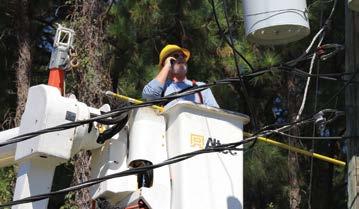
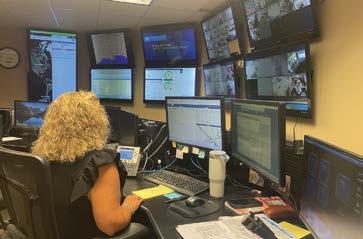












































































East Mississippi Connect fiber lines are integral to our community, providing high-speed internet and supporting the connectivity of many households and businesses. These lines, running parallel to EMEPA power lines, are vital for communication, education and daily activities. Any damage to these lines can result in extensive service interruptions.



As September ushers in the much-anticipated dove hunting season across Mississippi, it’s crucial to remind all hunters about a significant safety and service concern—watch for overhead power lines when hunting. While the thrill of the hunt calls, ensuring safety and uninterrupted service should be a top priority.

Shooting near power or fiber lines poses several risks. A misplaced shot can easily damage these lines, leading to costly repairs and significant service outages. More critically, there’s a considerable risk of electrocution. Power lines carry high voltage, and any damage can create dangerous situations not just for hunters but for anyone in the vicinity.











To ensure both safety and the uninterrupted service of fiber lines, hunters should follow these best practices:
1. Identify Safe Zones: Before setting up, identify areas free from power and fiber lines. Clear, open fields away from any infrastructure are ideal.
2. Be Aware of Your Surroundings: Look for power and fiber lines before taking any shot. Avoid shooting in their direction.











3. Use Proper Shot Angles: Always direct shots away from power and fiber lines. Shooting parallel to these lines increases the risk of stray shots causing damage.
4. Educate Fellow Hunters: Spread the word about the importance of avoiding power and fiber lines. Peer reminders can go a long way in preventing accidents.



If you notice any damage to power or fiber lines report it immediately. Quick reporting can prevent prolonged service outages and address any potential safety hazards promptly.






As we gear up for another exciting hunting season, let’s all do our part to maintain safety and service reliability. By being mindful of the East Mississippi Connect fiber lines and EMEPA power lines, hunters can enjoy their sport without harming critical infrastructure. Safety and responsible hunting practices ensure that we all benefit from uninterrupted services and a hazard-free environment.












Remember, the thrill of the hunt is best enjoyed safely and responsibly. Let’s make this season safe and enjoyable for everyone in our community. Happy hunting!






























Modern farming often relies on data and equipment with GPS and auto-guidance systems. Even with these modern conveniences, farm workers must remain vigilant. That’s because farming is considered one of the most dangerous jobs.
Massive machinery is indispensable to farming, but the same impressive size, height, and extensions make them particularly vulnerable to contacting power lines. That’s why staying alert, focused, and knowledgeable about potential hazards and safety procedures is crucial.
During a busy harvest season, the familiar sights around the farm can easily fade into the background, and farm workers can overlook the power lines overhead. However, failing to notice them can lead to deadly accidents.
Awareness of your surroundings, around, above, and below, and planning safe equipment routes can significantly reduce the risk of










accidents. Even with GPS and auto-steering, it’s imperative that farm workers keep a close eye on the equipment’s location and are ready to take action if necessary.
Exposed underground powerlines, defective wiring in farm buildings, and extension cords are also hazards. Grain bins can pose a potential danger as well. The National Electrical Safety Code requires power lines to be at least 18 feet above the highest point on any grain bin with which portable augers or other portable filling equipment are used. If you plan to install new grain bins or you’re concerned about the proximity of power lines to existing grain bins, contact Magnolia Electric.

by Scott Weeks
Manager of Safety and Loss Prevention










• Exercise caution near power lines. Be careful when raising augers or the bed of grain trucks around power lines.



• Use spotters when operating large machinery near power lines. Ensure the spotters do not touch the machinery while it is moving near power lines.




• Lower equipment extensions, portable augers, or elevators before moving or transporting equipment. Do not raise equipment, such as ladders, poles, or rods into power lines. Remember that non-metallic materials like lumber, tree limbs, ropes, and hay can conduct electricity, especially when damp, dusty, or dirty.
• Never attempt to raise or move power lines to clear a path. Doing so could result in electric shock or death.




• Avoid using metal poles inside bins. Don’t use metal poles to break up bridged grain inside or around bins.
• Hire qualified electricians. Ensure that qualified electricians handle work on drying equipment and other farm electrical systems.















by Scott Flood




From grocery store shelves to repair parts for vehicles, we’ve all had firsthand experiences with supply chain issues in recent years. So much so that the supply chain has become a convenient scapegoat anytime a business falls short of our expectations. But when it comes to your local electric cooperative, supply chain challenges are very real and often troubling.
Parts and components electric co-ops use every day are in short supply, which delays planned upgrades for power reliability and increases the costs of parts and labor.
Electric co-ops are working together to find innovative ways to deal with supply chain issues. This year, those e orts resulted in a major win regarding updated federal e ciency standards for distribution transformers that has co-op leaders breathing more easily.
Electric transformers are critical pieces of equipment that help deliver power to consumers. These essential devices adjust electricity voltage, either up or down, to enable safe and e cient power flow.
Late in 2022, the Department of Energy (DOE) proposed new e ciency requirements for the distribution transformers that deliver power to every home, school, and business in America. Among other provisions, the proposal would have required manufacturers of those transformers switch to amorphous steel within three years, in place of the grain oriented electrical steel (GOES) that has long been used. Amorphous steel is chemically altered in ways that may make transformers more e cient.
The National Rural Electric Cooperative Association (NRECA), the national trade association that represents more than 900 co-ops, is wary of DOE’s expectations for this change in material, and especially at a time when transformer manufacturers are already struggling to keep up with demand. Currently, there is only one U.S. producer of this specialty steel.
The availability of federal infrastructure funding is making it possible for co-ops to invest in the capacity, safety, and reliability of the systems delivering electricity to co-op communities. That’s a good thing for coops and their members, but it’s increasing pressure on the supply chain.
“The domestic supply chain hasn’t caught up with demand, and the industry is going through a learning curve,” notes Stephanie Crawford, NRECA regulatory a airs director. “It’s going to take some time for manufacturers to retool their production and producers to make enough amorphous steel to meet the need.”
While co-op leaders appreciate the significant amount of federal money being made available to update local energy infrastructure, that’s also putting the squeeze on supply.
Everyone across the country is making these investments at the same time, creating demand not just for new transformers, but for all the basic materials and equipment cooperatives need.
“Everyone across the country is making these investments at the same time, creating demand not just for new transformers, but for all the basic materials and equipment cooperatives need,” Crawford adds. “Amid all the challenges co-ops are already facing, it presents a big problem to ask the industry to make a 100% switch in just three years when the sole supplier only produces enough for about 5% of today’s market.”
NRECA and electric co-ops joined others in the power industry to educate key contacts in Congress, the White House, and DOE about supply chain challenges, particularly the requirements for the quick shift to amorphous steel.


“After more than a year of advocacy e orts, the DOE issued its final rule, which allows continued use of GOES in smaller-sized transformers,” Crawford explains. “This provides greater certainty with the transformer sizes cooperatives use the most, particularly in the residential segment.”
The DOE rule also includes a longer compliance timeframe for shifting to amorphous steel.
“Extending the deadline to 2029 will help manufacturers adapt for the future,” Crawford said. “The extension allows transformer manufacturers more time to adjust to the new standard and focus on output that electric cooperatives need.”
For the foreseeable future, electric co-ops will continue to face challenges in securing the supplies and equipment they need. The good news is that most have initiated processes to mitigate and manage those risks, so they can continue to meet their members’ needs. While the future availability of larger transformers remains a cause for concern, co-ops are pleased to see investments in U.S. manufacturing facilities, and that’s a hopeful sign.









For more than four decades, business writer Scott Flood has worked with electric cooperatives to build knowledge of energy-related issues among directors, sta , and members.

















































Modern farming often relies on data and equipment with GPS and auto-guidance systems. Even with these modern conveniences, farm workers must remain vigilant. That’s because farming is considered one of the most dangerous jobs.
Massive machinery is indispensable to farming, but the same impressive size, height, and extensions make them particularly vulnerable to contacting power lines. That’s why staying alert, focused, and knowledgeable about potential hazards and safety procedures is crucial.
During a busy harvest season, the familiar sights around the farm can easily fade into the background, and farm workers can overlook the power lines overhead. However, failing to notice them can lead to deadly accidents.










Awareness of your surroundings, around, above, and below, and planning safe equipment routes can significantly reduce the risk of accidents. Even with GPS and auto-steering, it’s imperative that farm workers keep a close eye on the equipment’s location and are ready to take action if necessary.
Exposed underground powerlines, defective wiring in farm buildings, and extension cords are also hazards. Grain bins can pose a potential danger as well. The National Electrical Safety Code requires power lines to be at least 18 feet above the highest point on any grain bin with which portable augers or other portable filling equipment are used. If you plan to install new grain bins or you’re concerned about the proximity of power lines to existing grain bins, contact Monroe County Electric.












• Exercise caution near power lines. Be careful when raising augers or the bed of grain trucks around power lines.
• Use spotters when operating large machinery near power lines. Ensure the spotters do not touch the machinery while it is moving near power lines.





• Lower equipment extensions, portable augers, or elevators before moving or transporting equipment. Do not raise equipment, such as ladders, poles, or rods into power lines. Remember that non-metallic materials like lumber, tree limbs, ropes, and hay can conduct electricity, especially when damp, dusty, or dirty.
• Never attempt to raise or move power lines to clear a path. Doing so could result in electric shock or death.




• Avoid using metal poles inside bins. Don’t use metal poles to break up bridged grain inside or around bins.
• Hire qualified electricians. Ensure that qualified electricians handle work on drying equipment and other farm electrical systems.















by Scott Flood

From grocery store shelves to repair parts for vehicles, we’ve all had firsthand experiences with supply chain issues in recent years. So much so that the supply chain has become a convenient scapegoat anytime a business falls short of our expectations. But when it comes to your local electric cooperative, supply chain challenges are very real and often troubling.
Parts and components electric co-ops use every day are in short supply, which delays planned upgrades for power reliability and increases the costs of parts and labor.
Electric co-ops are working together to find innovative ways to deal with supply chain issues. This year, those e orts resulted in a major win regarding updated federal e ciency standards for distribution transformers that has co-op leaders breathing more easily.
Electric transformers are critical pieces of equipment that help deliver power to consumers. These essential devices adjust electricity voltage, either up or down, to enable safe and e cient power flow.
Late in 2022, the Department of Energy (DOE) proposed new



e ciency requirements for the distribution transformers that deliver power to every home, school, and business in America. Among other provisions, the proposal would have required manufacturers of those transformers switch to amorphous steel within three years, in place of the grain oriented electrical steel (GOES) that has long been used. Amorphous steel is chemically altered in ways that may make transformers more e cient.
The National Rural Electric Cooperative Association (NRECA), the national trade association that represents more than 900 co-ops, is wary of DOE’s expectations for this change in material, and especially at a time when transformer manufacturers are already struggling to keep up with demand. Currently, there is only one U.S. producer of this specialty steel.
The availability of federal infrastructure funding is making it possible for co-ops to invest in the capacity, safety, and reliability of the systems delivering electricity to co-op communities. That’s a good thing for coops and their members, but it’s increasing pressure on the supply chain.
“The domestic supply chain hasn’t caught up with demand, and the industry is going through a learning curve,” notes Stephanie Crawford, NRECA regulatory a airs director. “It’s going to take some time for manufacturers to retool their production and producers to make enough amorphous steel to meet the need.”
While co-op leaders appreciate the significant amount of federal money being made available to update local energy infrastructure, that’s also putting the squeeze on supply.
Everyone across the country is making these investments at the same time, creating demand not just for new transformers, but for all the basic materials and equipment cooperatives need.
“Everyone across the country is making these investments at the same time, creating demand not just for new transformers, but for all the basic materials and equipment cooperatives need,” Crawford adds. “Amid all the challenges co-ops are already facing, it presents a big problem to ask the industry to make a 100% switch in just three years when the sole supplier only produces enough for about 5% of today’s market.”
NRECA and electric co-ops joined others in the power industry to educate key contacts in Congress, the White House, and DOE about supply chain challenges, particularly the requirements for the quick shift to amorphous steel.


“After more than a year of advocacy e orts, the DOE issued its final rule, which allows continued use of GOES in smaller-sized transformers,” Crawford explains. “This provides greater certainty with the transformer sizes cooperatives use the most, particularly in the residential segment.”
The DOE rule also includes a longer compliance timeframe for shifting to amorphous steel.
“Extending the deadline to 2029 will help manufacturers adapt for the future,” Crawford said. “The extension allows transformer manufacturers more time to adjust to the new standard and focus on output that electric cooperatives need.”
For the foreseeable future, electric co-ops will continue to face challenges in securing the supplies and equipment they need. The good news is that most have initiated processes to mitigate and manage those risks, so they can continue to meet their members’ needs. While the future availability of larger transformers remains a cause for concern, co-ops are pleased to see investments in U.S. manufacturing facilities, and that’s a hopeful sign.









For more than four decades, business writer Scott Flood has worked with electric cooperatives to build knowledge of energy-related issues among directors, sta , and members.












































by Miranda Boutelle
QHow do I use federal tax credits and rebates to upgrade my home?
ATax credits and rebates can help bridge the a ordability gap to higher e ciency equipment for your home, allowing you to complete energy e ciency upgrades that can lower your energy use and save you money in years to come.
First, knowing the di erence between a tax credit and a rebate is important. A rebate is a payment for purchasing or installing a qualified product or home improvement. Depending on how the rebate program is set up, it may be provided at the time of purchase or applied for and received after installation. Check with your electric cooperative to see if they o er rebates. Typically, the rebate is applied as a credit on your electric bill. In some cases, the rebate is provided as a cash payment to those who complete eligible projects.
A tax credit is a dollar-for-dollar amount that taxpayers can report on their tax documents to reduce the amount of taxes owed. You apply for a tax credit when you file your tax documents, so it typically takes longer to reap the benefits than it does with a rebate.
According to ENERGY STAR®, homeowners can qualify for up to $3,200 annually in federal tax credits for energy e ciency upgrades. Federal tax credits are available for heating and cooling system upgrades, including heat pumps, furnaces, central air conditioners, boilers, and geothermal heat pumps. Tax credits for ENERGY STAR®-rated heat pump water heaters cover 30% of the project cost, up to $2,000. You can also improve your home’s envelope — the portion of the home that separates the inside from the outside — with tax credits for insulation, windows and skylights.
If an energy e ciency upgrade requires improving the electrical panel in your home, there’s a tax credit for that, too. You can receive 30% of the cost of the panel upgrade, up to $600.
These federal tax credits are available through 2032. You must own the home you’re upgrading, and it must be your primary residence. Federal tax credits only apply to existing homes in the United States, not new construction.
The Inflation Reduction Act of 2022 expanded available funding for many home upgrades. The act allocated $8.8 million for home rebate programs to be implemented at the state level, and this funding is o ered in two di erent programs. The HOMES program allows up to $8,000 per home for standard-income households. Higher rebates are available for low- to moderate-income households. The HEAR program o ers rebates of up to $14,000 per home for qualified, e cient electric equipment for low- to moderate-income households.
These programs are designed to bolster existing programs and should be available in late 2024 or early 2025. Check with your electric cooperative or state o ce to find out if they are being o ered in your state.

When shopping for appliances, look for the ENERGY STAR® logo on the energy guide to identify which products are the most e cient options.

Tax credits for ENERGY STAR® heat pump water heaters cover 30% of the project cost, up to $2,000.
Additional energy e ciency rebates might also be available. More than half of U.S. states require energy e ciency programs for residents, according to the American Council for an EnergyE cient Economy. These programs can help people save money on their electric bills and help states meet climate goals, reduce system costs, and improve the electric grid.
I have had the privilege of working in energy e ciency rebate programs for many years and have seen the benefits of these programs firsthand. Tax credit and rebate programs can make upgrades more a ordable — helping people save money and improve the overall comfort of their homes.
Miranda Boutelle is the chief operating o cer at E ciency Services Group in Oregon, a cooperatively owned energy e ciency company.
















When we say that we live in a “connected” world, most of us think about technology, like our iPhones and gadgets. But when you’re a member of an electric co-op (that’s you!), there’s so much more to being part of our connected co-op community.
As member of North East Mississippi Electric Power Association, you help to power good in our local community through initiatives like the Community Cares Fund, Bright Ideas education grant, Youth Tour, and other initiatives that support the most vulnerable in our community. We depend on you because you power our success, and when North East Power does well, the community thrives because we’re all connected.
We greatly value our connection to you, the members we serve. And we’d like to help you maximize the value you can get from North East Power through a variety of programs, products and services that we o er our members. When you download our NEMEPA app, you can monitor and manage your home energy use, pay your bill online and access a menu of additional information.
When you follow North East Power on social media, you can stay up-to-date on power restoration e orts, elections, community events, and more. You’ll also see photos of our crews in action and our employees helping with community projects — and who doesn’t enjoy seeing good things happening in our community!






When you sign up for texting, you can receive advance notices on outage and restoration information, billing updates, and more.
By connecting with us, you can get real-time updates from your co-op. That’s why we want to make sure we have your most current contact information on hand. If we can’t connect with you on these platforms or in person, you could miss out on important information. Updated contact information can even speed up the power restoration process during an outage. Accurate information helps our outage-management system predict the location and the possible cause of an outage, making it easier for our crews to correct the problem.
We hope you will connect with us whenever and wherever you can — whether that means attending our annual meeting, providing feedback on a recent visit or call with our employees, or simply downloading our NEMEPA app.
North East Power exists to serve our members, and when we’re better connected to you and our local community, we’re better prepared to answer the call.
To update your contact information or to learn more about co-op products and services that can help you save, visit www.nemepa.org, call 662-234-6331 or stop by our o ce at 1389 Cooperative Way in Oxford.
We look forward to connecting with you!
To be nominated as director, you must:
• Obtain a petition with not less than 35 active, non-delinquent members that live in the district from which he/she is to be a candidate for director.
• Nominations must be received at least 45 days before annual meeting in order to be included on the ballot.
www.nemepa.org
Click on ABOUT at the top of the home page and then select Bylaws. Then click on NEMEPA Bylaws. Go to Article IV, Section 4.
A duly completed ballot shall constitute the sole and exclusive means of voting for candidates for director.
Members wishing to run for the board of directors should come by the o ce to pick up a packet which includes the Board of Director Qualifications and Eligibility and o cial nomination form.
Guidelines taken from bylaws. To view the bylaws visit, NEMEPA.org.
























EXPERIENCE is the third component in the Cooperative Youth Leaders program. Eighty-five rising high school seniors from across Mississippi traveled to Washington, D.C., to experience all facets of their nation’s capital city.
They visited, for a full week in June, along with nearly 1,700 student leaders from 44 states for the 2024 National Rural Electric Cooperative Association’s Youth Tour.
The trip was the culmination of the students’ participation in the Electric Cooperatives of Mississippi’s leadership program, which instills leadership skills, inspires creative thinking, builds confidence in decision-making, and introduces students to lawmakers that represent their communities.
During a March workshop in Jackson, which is the GROW component of the program, the students had the opportunity to meet and hear from state legislators. During the trip to Washington, D.C., the students met and spoke with their U.S. senators — Roger Wicker and Cindy Hyde-Smith.






While in Washington, D.C., the students and adult chaperones visited historic sites, monuments, museums, and had an opportunity to learn about the impact electric cooperatives have on their communities.
The students also had an opportunity to tour the U.S. Capitol, sit on the floor of the House of Representatives, and visit the Library of Congress as guests of former U.S. Congressman Gregg Harper of Mississippi.
The students attended a Washington Nationals pro baseball game and had dinner during an evening cruise on the Potomac River.
The students were chosen in the fall of their junior year of high school through North East Mississippi Electric Power Association’s Cooperative University and interviews, where they LEARNed .about their electric cooperative and the electric power industry.





The Cooperative Youth Leaders program is fully funded — including the trip to D.C. — by the local electric co-ops as a commitment to molding future leaders for Mississippi, so they can impact the state and local communities.




A’LAYAH BEAN
OXFORD HIGH SCHOOL
ANNA COOPER
LAFAYETTE HIGH SCHOOL
JADON DISHMON SOUTH PANOLA
LATHAN HENDERSON
POTTS CAMP HIGH SCHOOL
MARY MADISON KELLEY
LAFAYETTE HIGH SCHOOL
DREW KNIGHT
LAFAYETTE HIGH SCHOOL
JAKE LEARY
LAFAYETTE HIGH SCHOOL
GEORGE MONROE
OXFORD HIGH SCHOOL













SUNDAY, JUNE 16 EINSTEIN MEMORIAL










TUESDAY, JUNE 18 THE WHITE HOUSE






WEDNESDAY, JUNE 19

U.S. CAPITOL STEPS















THURSDAY, JUNE 20 THE KENNEDY CENTER







FRIDAY, JUNE 21

WASHINGTON NATIONAL CATHEDRAL












At NE SPARC, we are more than just an internet service provider; we are a growing part of the community we proudly call home. As a local company, we understand the unique needs and values of our neighbors, and we’re dedicated to delivering exceptional service and support to our subscribers. Our commitment to the community is reflected in everything we do, from our stateof-the-art fiber internet solutions to our 24/7 customer support.
In recent months, we’ve been busier than ever, expanding our reach and enhancing our services to meet the increasing demand for reliable, high-speed internet. We’re excited to share some of the latest events and product o erings that have been designed with our subscribers in mind.

In July, NE SPARC hosted our first SPARC Session to educate our subscribers about di erent ways they can use fiber internet in their homes and businesses. The first topic was streaming television and movies. We had a great group for our first class and plan to incorporate new topics into each future session.
NE SPARC is proud to partner with North East Mississippi Electric Power Association for our third annual Bright Ideas grants for local school teachers. Bright Ideas grants are awarded to public school teachers that have students who are our members/ subscribers. These $500 grants are awarded for innovative, classroom-based education projects. The deadline for the 2024-2025 school year is September 4. Find out more, or apply online, at www.nemepa.org/brightideas.




Need your work laptop to get network priority? No problem. You can set the app to do that. Want to set screen time limits for the kids? No problem. You can do that as well. You set the rules, we enforce them. With ExperienceIQ from NE SPARC, subscribers can easily create and enforce online rules for the users and devices on their home network.



ExperienceIQ from NE SPARC is an add on to your account through the NE SPARC CommandIQ app. The cost is $5 a month, and it is easy to set up. To add ExperienceIQ to your account, simply call us at 662-238-3159.
Streaming isn’t always easy to navigate. There are so many platforms and changing prices, and finding where your shows are available can be challenging. NE SPARC’s partner, MyBundle, has solved all these problems. And it is totally free! Visit www.nesparc.com/streaming and take a short quiz about your viewing preferences to learn what platforms would be best for your family. You can also compare pricing, as well.



When you think of technical support, you probably think of times when your internet isn’t working. However, NE SPARC’s 24/7 support goes far beyond that. Our subscribers can call us for help with connecting devices to the network, setting up parental controls, establishing a guest network for their home, or resolving phone issues. Our dedicated support team is here to assist with any needs, and best of all, it’s free for NE SPARC subscribers. Reach us anytime at 1-833-NESPARC.
We are grateful for the trust and support of our subscribers, and we will continue to strive for excellence in everything we do. Whether through our cutting-edge technology, exceptional customer service, or community involvement, NE SPARC is dedicated to keeping you connected and supporting the place we all call home. Together, we are building a brighter, more connected future.




















The beginning of September starts one of my favorite times of the year. Our young people return to school, football, and other activities begin, and our sense of community is reestablished after the summer break. We anticipate the first glimpse of fall and the hopes of getting extreme heat and high electric bills behind us.
As our young people return to class, a good amount of time will be spent online completing classwork as well as beginning and maintaining friendships. Recently, the U.S. Senate passed the Kids Online Safety Act (KOSA). For the first time since 1998, Congress acted to pass legislation to have tech companies take measures to mitigate harm to minors using their platforms online. As parents, you can take steps to reduce this risk as well. Northcentral Connect, our high-speed internet a liate, o ers a service known as Bark. This product allows parents




to stop cyberbullying and other threats online. Call us or visit northcentralconnect.com for additional information.
Fall will arrive. I promise.
Stay safe.





At Northcentral we realize the value added to our community with reliable electric power and high-speed internet. Delivery of these critical products must and will be done in a safe fashion.
by Kevin Doddridge General Manager/CEO




















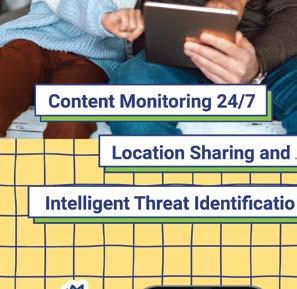


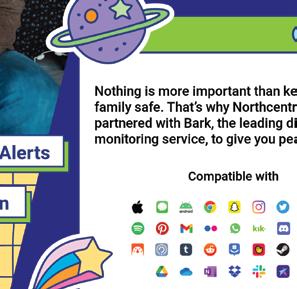









































Pearl River Valley Electric has endeavored to provide high quality electric service at the lowest possible cost, and your Board of Directors is committed to meeting the needs of the membership by maintaining economic strength and stability for the Association.
Over the last year, one of the greatest factors that has impacted members’ bills is extreme heat and cold. Last summer, we saw record high temperatures, and this summer has been extremely warm too. Our winters have also been less mild with cold snaps driving up electric bills. These hot and cold periods increase the amount of energy you use from month to month and can cause your heating and cooling system to run longer, increasing your home’s energy use. While we work hard to keep costs down, we understand that the weather is unpredictable. We do recommend inquiring about ways you can keep your energy bills lower during extreme temperatures.
Purchasing wholesale power accounts for nearly 67% of our overall cost of providing electric service to members. PRVEPA is a member-owner of Cooperative Energy, a generation and transmission cooperative. This arrangement ensures us of having our wholesale power delivered on a not-for-profit basis.



















Cooperative Energy’s strategy to generate electricity is to use a broad mix of fuels — including coal, gas, nuclear, hydro, and other renewable sources — which helps keep costs as low as possible. Finding new, cost-e ective ways to meet our wholesale power needs is a continuing priority and your PRVEPA Board of Directors will be closely watching developments throughout the industry.
The launch of our fiber internet company, PearlComm Fiber was an exciting moment in 2021. Now over three years later, we have seen them connect nearly 15,000 members with high-speed internet. The board is proud of the role it played in creating PearlComm, and we look forward to seeing the company complete its work within our service territory next year.
The electric cooperative holds its Annual Meeting so that you, our members, can have a say in the direction of the Association. As a member you play an important role in the path the cooperative takes. I encourage you to be active and informed and to attend our annual membership meeting on Sept. 28, 2024. As president of your Association, I am proud to present this report for your consideration.
The Association’s records and accounts were audited by Topp, McWhorter, Harvey, PLLC, Certified Public Accountants. The report was complimentary of your CEO/general manager and sta . It also showed the records and accounts in excellent condition and that the Association is in a financially strong condition.
The following is from the annual audit dated Dec. 31, 2023:
• Net electric plant increased $49,442,219, bringing the total to $279,965,237.
• Assets total $386,957,371, which reflects an increase of $64,465,162 for the year.
• The member-owners of Pearl River Valley Electric Power Association have equity of 36% in the system.
Your Board of Directors is dedicated to the principle of returning patronage capital to our member-owners — in fact, we were the first electric power association in Mississippi to start paying regular patronage returns.


























Patronage capital, or capital credits, represents members’ investment in their not-for-profit electric cooperative. Each year, rates are set so that the Association has enough funding to operate throughout the year, and any year-end revenue above the cost of providing electric service is assigned to members as margins based on their share of electricity use. A portion of those margins is then returned to members each August. This year, we returned $3.6 million to our members.
We have now made patronage returns to our member-owners for 60 years, totaling nearly $75 million. Very few electric cooperatives in the nation can surpass our record of paying patronage returns to their members.
In 1988, your Board of Directors started a program where we return the accumulated patronage capital to the estates of deceased members. In addition, a program for o ering discounted capital credit refunds to former members was initiated in 2016. We have returned more than $19.3 million through these programs, including $1,059,000 in 2023.

All members of Pearl River Valley Electric Power Association are invited to attend the annual meeting of members on Saturday, Sept. 28. Registration will begin at 9:30 a.m. at the Lawrence Building at Pearl River Valley Electric’s headquarters o ce at 1422 Highway 13 N., Columbia, MS 39429. The meeting will begin at 10:30 a.m.
As a member of Pearl River Valley Electric, your participation at the annual meeting is vital. At the annual meeting members vote to elect directors, hear reports covering the operation of the Association and to transact other business that may come before the meeting.
INCLUDED ON THE AGENDA IS THE ELECTION OF THREE DIRECTORS TO THREE-YEAR TERMS:
DISTRICT 3
Hugh Gene Smith (Nominated by Nominating Committee)

DISTRICT 6
Matt Thomas (Nominated by Nominating Committee)
DISTRICT 8 Je Tinnon (Nominated by Nominating Committee)

PRVEPA will award 13 attendance prizes, including a $1,000 certificate for electricity. You must be present at the meeting to be eligible for the attendance prizes. If you cannot attend the meeting, mail in your annual meeting ballot today. By returning your ballot, you are eligible for the absentee prizes.


Throughout our storied history, spanning nearly nine decades, we have encountered numerous challenges that have tested our cooperative. From storms and economic fluctuations to pandemics and supply chain issues, each obstacle has presented an opportunity for us to evolve, adapt, and emerge stronger than before. This year has been no di erent.
As in previous years, we are still contending with economic uncertainty. While inflation has eased o slightly, the price of materials is still higher compared to pre-pandemic years. Despite this we are being proactive by stockpiling equipment and looking at various distributors and companies across the U.S. for the best prices and inventory available.
Our service territory for the last few years has been blessed with limited severe weather. However, this last spring, we saw multiple rounds of storms that caused outages. The most notable storms were in May and caused extensive damage in the Bunker Hill and Bassfield areas. Crews worked for four days to restore power to these areas while battling di cult terrain. In total 201 poles were broken from straight line winds. Thank you to the Pearl River Valley Electric linemen and contract crews who worked long hours to restore power.
One recent trend that concerns me is the rise of scams that are targeting Pearl River Valley Electric members. In an era where technology has connected us in unprecedented ways, it has unfortunately also provided a platform for those with ill intentions to prey on unsuspecting victims.
Scammers targeting cooperative members employ a variety of tactics to deceive their targets. One common approach involves phone calls from individuals posing as representatives from Pearl River Valley Electric. These scammers often use fear tactics, claiming that the member’s service will be disconnected immediately unless a payment is made. They may even manipulate caller ID systems to make it appear as though the call is coming from Pearl River Valley Electric. Members should exercise caution and avoid providing personal information online or over the phone. If you suspect a scam, give us a call.
Solar power is a booming business, and as technology improves members are finding benefits in residential solar installations. However, some members are falling victim to predatory solar companies. While many of these companies are legitimate, some aim to take advantage of members by promising energy independence and selling them expensive systems with little return on investment. Unfortunately, in many cases the company goes out of business, leaving our member with no one to service the equipment. At Pearl River Valley Electric we want to make sure you are aware of the benefits and the potential risks of solar power. On our website, we have a solar calculator which can estimate whether solar is right for you. We also encourage you to call us and speak with someone before making any decisions.












PearlComm Fiber, our sister fiber company, has shown that high-speed internet is as innovative and important to rural areas as electricity was in the 1930s. PearlComm Fiber is changing lives by giving Pearl River Valley Electric members access to telehealth, online job opportunities and virtual education.
PearlComm has reached numerous milestones this year, including the connection of its 10,000th customer in February and its 13,000th in June. This growth has been spurred on by the hard work of PearlComm employees and contractors. We expect PearlComm Fiber to open the last areas within our service territory for installations in early 2025.
For 2023, the number of meters served by the Association increased 1.22% from 52,678 to 53,323 while our annual sales of electricity — 1,119,139,350 kilowatt hours (kWh) — were about 6.2% above 2022.
Maintaining reliable service to our members requires continual planning and upgrading of our lines and equipment. In 2023, our crews added nearly 30 miles of new overhead and underground lines to our system, which totaled 6,296 miles of lines and 24 substations throughout our 12-county service area.
Right-of-way (ROW) trimming is a key component of our maintenance program. Our goal is to rotate through our entire system every 10 years, which means we trim nearly 500 miles of ROW annually. Our right-of-way program is also an essential part of limiting long-term outages.
This year we used a combination of trimming and cutting trees along with the application of economical and environmentally friendly herbicides. Thank you for your understanding and cooperation as we work to maintain a safe and reliable system for our members.
Pearl River Valley Electric has an excellent outage record that is well below the national average. Typically, our members experience very few outages lasting only short amounts of time, which is remarkable when you consider that electric service is a 24/7 commodity. However, despite our best e orts to provide excellent service, we are still at the mercy of severe weather.
Along with our ROW maintenance, we continue to implement a pole inspection program to replace poles that could cause power outages. As always, over the past year we also replaced, upgraded, or retired equipment and facilities as needed.
Safety is our top priority at Pearl River Valley Electric. If we do not operate safely, then it is nearly impossible to provide a ordable and reliable electric service to our members. Our employees are some of the best in the industry; I’m proud to say





that they are committed to working safely daily. We will continue to focus on safety to ensure the well-being of employees, members, and the public.
Pearl River Valley Electric strives to o er a variety of online tools to help you in your busy life. We also o er programs to help our members further their education and broaden the horizons of our youth.
Through our website, www.prvepa.com, you can access EmPowered, our customer portal. Through EmPowered you can pay your bill, access your energy use history, and report outages. Our website also houses a Help Center which contains a wealth of information from bill payment options to energy e ciency brochures.
While our website is our flagship for communication, we also understand that much of our members’ work is done on mobile devices. We o er a mobile app that o ers similar services to our website. You can access the app by searching for “PRVEPA” in your app store. It is free. To expand our payment options through the phone, you can now pay by texting. Simply, text “Join” to #352667 and follow the prompts. You can then text “Pay” to #352667 in the future to pay your bill.
@MyPRVEPA
It’s important for our members to stay informed, especially during severe weather and large-scale events like storm restoration. For this reason, we use our Facebook and Twitter pages to supply upto-date information. These sites are meant to educate and inform our members about our cooperative. During major outages, we can share information regarding restoration e orts and provide updated outage numbers. In addition, these sites will be used to alert members to important information such as scam alerts, program and policy information, and news about the positive impact your cooperative is having in the community. These sites aren’t monitored 24/7, so we ask that you refrain from posting outage notifications.
As an electric cooperative, it is our job to not only provide electricity, but to improve the lives of our members and communities. In the last year, we have performed safety

demonstrations for schools and have collaborated with our partner CoBank to distribute matching funds to local volunteer fire departments and a children’s home. We have also partnered with area high schools to educate students about careers in the electric power industry.
Pearl River Valley Electric continues to proudly serve its members through our facilitation of the Round Up for Education Program. Over the last 11 years, our members have helped over 2,000 students achieve their dreams of higher education simply by donating a few cents each month. In fact, since the program’s creation, more than $2 million has been distributed to students through scholarships to Mississippi community colleges. This program is truly a perfect example of how a member-owned cooperative can help the communities we serve.



Our Cooperative University, the first step in our Cooperative Youth Leaders program, was once again a success. In November, 28 students met at the Columbia National Guard Armory to take part in a daylong event that included leadership and team building exercises and speakers from Pearl River Valley Electric, the Electric Cooperatives of Mississippi, and Cooperative Energy. Students were able to take part in lineman exercises and discuss important topics with area legislators.
Judges interviewed all 28 students and chose two winners to represent PRVEPA. This year’s winners were Mary Xie and Stevie Thompson of Oak Grove High School. Both participated in a Youth Leadership Workshop in Jackson and visited Washington, D.C. in June. While there, they met with lawmakers, toured the city, and saw many sites throughout our nation’s capital.
We are extremely excited for both Mary and Stevie and look forward to seeing their lives and careers blossom. We are also eager to select two more representatives at this year’s Cooperative University in November. If you are interested in more information on this program, please visit our website, www.prvepa.com.
As we reflect on another challenging yet rewarding year, it is clear that our resilience, and commitment to our members continue to drive us forward. Our cooperative has not only faced obstacles headon but has also seized opportunities to enhance our services and strengthen our community bonds. As we look ahead to the future, we remain committed to advancing our infrastructure, enhancing our services, and fostering a sense of community that is integral to the cooperative spirit. Thank you for your continued trust and support.
Pearl River Valley Electric is excited to have area high school juniors participate in our Cooperative Youth Leaders program. If you are an 11th grader served by Pearl River Valley Electric Power Association, check with your guidance counselor about this lifechanging program.
Every year, Pearl River Valley Electric chooses two students to represent the cooperative at a leadership workshop in Jackson and for a week-long tour of Washington, D.C. in June. Pearl River Valley Electric’s Cooperative University is the first step in the Electric Cooperatives of Mississippi’s Youth Leadership Program which has been going for 38 years.
The Cooperative University is a one-day event where each school within PRVEPA’s service territory will be represented by two






students. Each student is expected to attend the all-day event in its entirety. The day will consist of speakers, games, lunch, and various demonstrations. This year’s Cooperative University will be held on Nov. 6 at the National Guard Armory in Columbia, beginning at 8:30 a.m. and concluding by 3:30 p.m.
At PRVEPA’s Cooperative University, students will learn about Pearl River Valley Electric and what it means to be a member. They will learn how electric cooperatives began, how electricity is produced, and much more. Each student will also participate in an interview process, by a panel of judges, to be one of two students chosen for the leadership program.
Homeschooled students are also encouraged to apply, please call 601-731-7830 for more information.























PONTOTOC 662-489-3211 • Fax: 662-489-5156
P.O. Drawer 718 • 12 South Main Street, Pontotoc, MS 38863

662-983-2727 • Fax: 662-983-1335
Box 415 • 129 South Newberger Street, Bruce, MS 38915


















Electrical safety is important for us all, but new parents, make sure you review these tips to keep your little ones safe:
• Regularly check electrical cords for damage or exposed wires.
• Keep electrical items a safe distance away from any water source.


• Ensure GFCI electrical outlets are installed in rooms with water sources.
• Secure heavy electronics like TVs to prevent them from being pulled down or knocked over.
• Keep electrical cords away from high-tra c areas in the home.


• When they’re old enough, teach children about the importance of electrical safety.




















































by Jennifer Johnson







PEPA member and Pontotoc High School's Joy Chunn believes her role as a teacher and advocate for children has always been God’s plan for her life. “Growing up, I knew I wanted to be a teacher of some sort and a mama. My mother always worked with children and preschoolers, and she truly was my first teacher.”
As a student at Tupelo High School, Chunn signed up for a Spanish class. Her teacher was Josefina Rayburn, a native of Aguascaliente, Mexico, who came to the U.S. to get a license to teach. Chunn said Rayburn’s background was invaluable. “Having a native Spanish speaker was a great gift.”
Another opportunity to learn Spanish came when Rayburn asked Chunn’s parents to host a student from Mexico. Chunn called it “a wonderful opportunity to build a friendship and learn from a native Spanish speaker.”
Chunn took three Spanish courses while attending THS (where she graduated valedictorian!). After high school, Chunn went on to Blue Mountain Christian University. She told her advisor her plan was to major in elementary education and Spanish. But the advisor discouraged Chunn’s plans of continuing to immerse herself in learning a foreign language, telling Chunn “you’ll never use that in Mississippi.”
After much prayer, Chunn decided to go ahead with her plan. She graduated with a major in modern languages, and to say she has used it in her career is an understatement. Her first teaching



job was with Columbus High West and Columbus High School, where she taught Spanish I and II and co-sponsored the Spanish club and the National Spanish Honorary Society. She then taught Spanish at Shannon High School for four years, followed by a stint at Pontotoc High School teaching Spanish I – IV. Her former PHS principal Chad Chism left to oversee Pontotoc Elementary and Chunn moved there.
“He realized English as a second language was a growing population and needed someone who could communicate with those families.”
At the time, Chunn was not English as a Second Language (ESL) endorsed, but she went back to get her master’s degree in literacy education and gained that endorsement. She said she learned an important lesson there.
“There are so many little things in English that are not normal. It truly helped me understand just how hard English is to learn.”
She taught at Pontotoc Elementary for nine years, and at one point worked with 103 kids. She’s quick to point out she’s not alone in helping the ESL population. “We have a team of ESL teachers, and we are very fortunate to have a good number of teachers and paraprofessionals who are bilingual.” From there, she was the ESL for students at Pontotoc High School for two years.
Now, Chunn has taken on a new role in the Pontotoc school district as the director of English Language Services and is leading the newcomer program (housed at PHS), which targets students who



enter an English-speaking school and have fewer than two years of exposure to English.
Chunn said she believes God had her career mapped out all along. “He put so many things in my path to allow me to serve this way and help kids grow.”
And she’s not only serving in the school system. She and husband Gary have been foster parents to two Spanish-speaking sibling groups.The first pair of boys have now gone back to their mother in Mexico, but Chunn still hears from the young men. “We’re still very close. They call me at least once a week. We text back and forth, and they send me pictures.”
The Chunns have three boys of their own, and Chunn was son Ayden’s Spanish I teacher, an opportunity she called "cool.”
Chunn said she saw another former student who had saved all the learning aids Chunn had given her class. She told Chunn she brings that binder to her job as a nurse to help her communicate with patients who do not speak English.
He realized English as a second language was a growing population and needed someone who could communicate with those families.
She said during the span of her career, she has had some wonderful interactions with former students who have told her how her teaching and mentoring have helped them into adulthood. “I had a student at Shannon High School who struggled with learning Spanish, but he had quite a gift of creating with his hands. I had encouraged him to do something with pottery. I ran into him recently, and he told me he is now an art teacher specializing in pottery.”
She's been recognized for her accomplishments, being chosen as the PHS Teacher of the Year and the District Teacher of the Year for the 2023-2024 school year.
Chunn is coming into her 30th year in teaching, and Chunn said she could never see herself leaving education completely. “Right now, my plan is to stick with it for 35 years. Then I might do something di erent, but it will probably be working with teachers in some capacity. I love teachers and the impact they have.”
And does she have any advice for those just getting started in the education field?
“Make sure you remember that a student is more than a learner. We have a generation of kids now who don’t always have someone investing in them. Many children are growing up with an iPad or a television. Be diligent in making the time to talk to and not just teach those kids. They need a person who sees them.”











INGREDIENTS
3 tablespoons Dijon mustard
6 boneless pork loin chops, 8 ounces each and ¾ inch thick
1⁄3 cup seasoned bread crumbs
Preheat oven to 375 degrees. Spread mustard onto both sides of pork chops; place on a greased baking sheet. Mix bread crumbs with a dash of pepper and press mixture onto top and sides of chops. Bake until lightly browned. Look for thermometer reading of 145 degrees. Let stand five minutes before serving.
INGREDIENTS
1 pre-baked 12-inch pizza crust
2⁄3 cup honey garlic bbq sauce
1 small purple onion, chopped
1 cup cubed cooked chicken or rotisserie chicken
2 cups mozzarella cheese, grated
Place crust on pizza pan. Spread bbq sauce to within a half-inch of crust edges. Sprinkle with onion, chicken, and cheese. Bake at 350 degrees until cheese is melted.

INGREDIENTS
6 half ears corn
2 tablespoons butter, softened
½ cup parmesan cheese, grated salt to taste pepper to taste
Preheat oven to 375 degrees. Coat each ear of corn in a thin layer of butter and roll in parmesan cheese to coat. Place corn in a square baking dish and sprinkle with salt and pepper. Bake for 25 minutes.
INGREDIENTS
10 large vine tomatoes, halved
4 garlic cloves, sliced
½ bunch thyme
3 tablespoons balsamic vinegar
2 tablespoons olive oil
Heat oven to 350 degrees. Sprinkle garlic and thyme on tomatoes, and place them on a baking sheet. Drizzle balsamic vinegar and olive oil. Roast for one hour. Remove and set aside to cool.
























BRIAN HUGHEY General Manager & CEO
NEELY MCLEOD Marketing Specialist


I’m sure many of you have children or grandchildren who are settling into the new school year. These are exciting times for students, teachers, and parents. In addition to the normal back to school jitters, children may be attending preschool for the first time or advancing from middle school to high school, and parents may be sending a child o to college or to the final year of high school.
Having great teachers and administrators at our local schools can give students and parents comfort during the school year. These special individuals need the community’s support as they play a critical role in the development of our children and grandchildren.
Singing River Electric is committed to the schools in our communities. Our engineers and





linemen visit elementary school classrooms across the service territory demonstrating the importance of electrical safety. We sponsor a youth leadership program for high school juniors, participate in the Pathways2Possibilities Career Fair to help local middle school students explore job fields and potential careers, and contribute to local chambers of commerce scholarship programs for those entering college.
Education is vital to the economic growth and well-being of the communities where we live and work. I ask you to join us in supporting our schools and teachers through volunteering or helping in some way. Our students deserve nothing less than the best education we can provide them. Thank you to our local teachers and administrators for serving in such important roles.
by Brian Hughey
General Manager and CEO













AMANDA PARKER, CCC Manager of PR and Marketing









PR and Marketing Coordinator











With temperatures still in the high range, here are a few things to remember to help reduce your energy use.
• Schedule maintenance on your HVAC (heating, ventilation, and air conditioning) system if you haven’t already this year. Your system has been working hard to keep your home cool through the heat of summer, and you want it to continue and operate at maximum e ciency.
• Change or clean your air filter regularly. Most manufacturers and HVAC companies recommend changing your filter at least every 90 days. If you have pets in the home, keep an eye on your filter in case you need to change it more often.

• Run appliances, like your dishwasher and clothes dryer, at night. These appliances create heat and humidity in your home. Clothes dryers take in conditioned (cool) air and give o hot air during the drying period. A dishwasher releases hot, humid air into your home throughout the washing cycle. Running these appliances at night helps keep unwanted hot and humid air from being created during the hottest parts of the day when your HVAC system is already working harder to condition the air in your home.
Built by the communities we serve, Singing River Electric recently had several opportunities to give back to our local areas and live out the 7th Cooperative Principle – Concern for Community.
A $1,649 Neighbors Helping Neighbors Community Grant purchased a washer and dryer for Benndale Elementary’s Giving Closet, which not only supplies students' basic needs but is also an instructional tool allowing students to create a solution to benefit their school community.
According to teacher Jennifer Finley, one in five students does not have access to clean clothing, making them more likely to miss school. This fact makes it important for students to have clean clothes, shoes that fit, and their hygiene needs met.

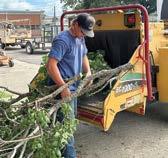
Singing River Electric employees removed limbs, cut grass, and performed other lawn work to help George County Middle School prepare to welcome students this fall.
Right-of-way contractor Treeline Services also helped with this project.


Employees volunteered at The Link Family Resource Center in Hurley by sorting items for their school supply drive. This organization, serving Jackson, George, and Greene counties, offers directive services and resources for families, individuals, and support groups.


CASA (Court Appointed Special Advocates for Children) of Southeast Mississippi received a $2,138.93 Neighbors Helping Neighbors Community Grant to purchase a portable public address system. This organization serves more than 400 children in the court system who have substantiated reports of abuse or neglect in Jackson, George, and Greene counties. With nearly 100 volunteers, the AV equipment will be used at volunteer drives and community awareness events to more effectively spread the message and help more children.

































































With our SmartHub mobile app, you can pay your bill and change your payment method – all with a few quick taps on your phone screen.




1. Download the SmartHub app from the iPhone App Store or the Android Marketplace. (Please note SmartHub is one word.) If duplicate apps appear with the same name, National Information Solutions Cooperative provides the correct app.
2. Find “Singing River Electric” by location or name and confirm.
3. Enter email and password or select, “New User” if you have not already established a password to pay your bill online.

Singing River Electric is building its SCADA (supervisory control and data acquisition) system which uses software and fiber lines to collect and analyze real-time data from its substations.
Employees recently commissioned the Benndale substation in George County and the Aleco substation in Jackson County for SCADA, which included verifying communication from the Lucedale o ce to the substations and vice versa and checking safety features and controls on all substation devices. These two substations are the latest to have fiber spliced to allow communication with the Lucedale o ce, and meter readings are now

traveling over the fiber network instead of the radio system.
Member benefits from SCADA include faster outage restoration times, improving reliability, and receiving more information to perform proactive system maintenance.










On October 1, Southern Pine will kick o our Members Helping Members program. With this program, your bill will automatically be rounded up to the nearest dollar and used to support our communities. Members Helping Members is a simple, voluntary way to make a big di erence, and the money goes towards helping the people Southern Pine serves.
For example, a bill of $82.75 would be rounded up to $83. The extra .25 cents is placed in the Members Helping Members Trust Fund, which provides fi nancial support for charitable causes and non-profit organizations within the 11 counties Southern Pine serves. Your spare change can fund charitable projects, equip emergency services, upgrade classrooms and playgrounds, and more. The average amount a participating member contributes is about $6 a year.
If the Members Helping Members program isn’t right for you, opting out is straightforward. You can do so by scanning the QR code on below, visiting Southern Pine.coop/MHM, or just giving us a call. Before you decide, consider the collective impact of this program.
I understand that $6 a year may not seem like much, but when combined with all the members of Southern Pine, it can make a significant di erence in our communities.
The 7 Cooperative Principles guide Southern Pine and other electric cooperatives in everything we do, and one of the principles is Concern for Community. Members Helping Members allows all of us to come together to fulfill that principle. Together, we can make a significant impact and help our communities for years to come.

by Chris K. Rhodes
President/CEO Southern Pine Electric
Your spare change can make a big di erence through the Members Helping Members Program. Participating Southern Pine members’ bills are rounded up to the nearest dollar, and the amount collected benefits members in Southern Pine’s 11-county service area. For less than two cents a day, you can be part of making a meaningful impact right here at home. Working together, the cooperative way, we can make a di erence.
SCAN TO LEARN MORE OR OPT OUT
































Being a Southern Pine Electric Cooperative member is di erent from simply being a customer. Our members are invited and encouraged to be active in the cooperative, and the co-op has a responsibility of involvement in the communities we serve. It is one of the guiding principles that we abide by in our day-to-day work. That is why we are launching a new voluntary program, Members Helping Members, where members can help support each other, and their own communities.
While this program, commonly known as Operation Round-Up, is new to our members, it has a proven history of success across the United States and at other co-ops in Mississippi. For decades, these programs have benefitted thousands of rural electric cooperative members, and now, we are excited to be able to help our members enjoy the same proven benefits through Members Helping Members.
By rounding up your electric bill, averaging .50 cents a month, you can help area charities, students, teachers, educational projects, safety programs, shelters, senior citizens, and numerous other community service projects that can directly benefit you and your family. Funds stay in the 11-county area served by Southern Pine, helping to make life better for you, your family, and neighbors.
Beginning in October 2024, bills will be rounded up to the nearest dollar. For instance, if your bill is $145.50, it will be rounded to $146. On average, members will donate around $6 annually per account to the program. While this may seem like a small amount, we can make a significant di erence by using pocket change to make a lasting impact in local communities.
Through members’ generosity, and participation in this program, we can help bring hope and opportunity to our own communities. This is just one more example of what it means to belong to a cooperative and how a tiny bit of change can make an enormous di erence.
Contributions will be placed in a separate, audited Members
Helping Members Trust Fund administered by the Pinebelt Foundation, a charitable organization described in Sections 501(c )(3) and 509 (a(1) of the Internal Revenue Code. Acting as a charitable support service provider, the Pinebelt Foundation has been helping charities for over 25 years. Southern Pine’s board of directors, management, or employees will not make decisions on the awarding of funds.
To ensure that members know their donations will go to worthwhile community causes within the co-op’s service territory, and that members are actively participating in the process, an 11-member advisory committee, consisting of one member from each county served – Copiah, Covington, Newton, Scott, Simpson, Forrest, Jasper, Je erson Davis, Smith, Lawrence, and Rankin -- will be selected. The advisory committee will review grant applications, after the Pinebelt Foundation has verified eligibility, and recommend awards. Each advisory committee member will serve for three years, and then other Southern Pine members will be selected to serve.
“We hear from our members that they want us helping in their communities to promote service programs that benefit their families and others. We can do that through Members Helping Members in a painless way. The average monthly contribution is less than the price of a canned drink. We could not make a di erence doing it alone, but if we join together, in the cooperative spirit, then we can make an enormous di erence. This program allows us all to help each other, and I am happy to be a part of it,” said Jan Collins, vice president of communications.
We hope you will be as eager as we are to bring the benefits from this program to your family, neighbors, and communities. However, we want to emphasize that participation is entirely voluntary, and members may opt out at any time. If you decide not to participate, we have made opting out easy. Scan the QR code to find out more information or to opt out. Complete the short form and you will be opted out of the program. You can also complete the opt-out form on the Southern Pine website, at www.southernpine.coop/MHM, email us at optout@southernpine.coop, or call us at 800-231-5240. The choice is yours.

SCAN TO LEARN MORE OR OPT OUT




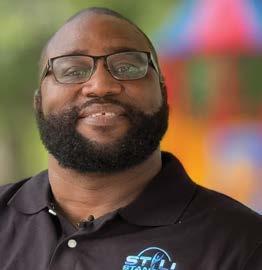









































There are hundreds of co-ops that participate in round-up programs across the nation. Each program directly benefits the members of the individual cooperative and funds stay within its service territory. Check out a few of the ways 4-County Electric and Coast Electric help their co-op’s members and then imagine the impact Members Helping Members can have within the communities we serve.



Over 55 Southern Pine members from Copiah County joined us for the Copiah County Member Circle in early August at the Family Fish House in Hazlehurst. Members enjoyed great food and fellowship and heard from Brandon Henderson, the New Hebron District Manager. Henderson spoke about the New Hebron District, and employees were on hand to answer any questions.
Jan Collins, Vice-President of Communications at Southern Pine, spoke with the group about several programs that could be helpful. She gave an overview of the new bill format, discussed texting for outages, and introduced the new round-up program, Members Helping Members, and how beneficial the program will be to all counties in Southern Pine’s service territory.
“I love Member Circle meetings because we get to fellowship with the members, discuss important topics, and listen to members’ questions and concerns,” said Collins. “Our goal in the communications department is to be transparent in everything we do because the members are the owners of Southern Pine and have a stake in our success. We want to talk about the great things happening, but we also want to address any issues they may be having and try to help find solutions.”

Charles Lowe, Southern Pine board member from Copiah County, and Billy Berry, Southern Pine board president from Simpson County, attended the event to meet some of the members they serve.
Southern Pine holds Member Circle events in each of the 11 counties we serve on a rotating basis. We look forward to being in your county soon.
























































We were pleased by the turnout at the 2024 Annual Meeting at Cornerstone Church in Natchez on Wednesday, August 14. Members who attended were entered into the drawing for door prizes. Congratulations to the winners listed below.
Members who could not attend the meeting and returned the bottom portion of their Annual Meeting Notice were entered into the drawing for ten $100 bill credits. Those winners are also listed below.
We look forward to seeing everyone next year at the 2025 Annual Meeting.

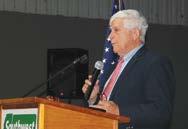



for returning the bottom portion of the Annual Meeting Notice:
Debbie Foster, Copiah County
Mary Franklin, Je erson County
Danny Channell, Copiah County
Richard Britt, Lincoln County
Pat Porter, Adams County
Garry Pickering, Lincoln County
Brian McKlemurry, Franklin County
Cesa Rosiek, Adams County
Michael Robinson, Claiborne County
RC Williams, Adams County

Rickey Blalock, Amite County
Lillian Clark Edney, Adams County
Claudia Stephens, Adams County
Alvin Hauer, Adams County
Diane Herring, Lincoln County
Samuel Johnson, Adams County
Sadie Jones, Adams County
Travis Patten, Adams County
Francis Ransom, Jr., Adams County








Stop hot air from infiltrating your home by using caulking to plug holes, cracks and open seams around the exterior of your house. Either use a high-quality caulk or expanding foam sealant and fill any and all air-leaking gaps.

Inspect the weather stripping around all exterior doors to ensure that it is not ripped, crushed or missing. Try closing the door and check for air-leaking gaps around all four edges of the door. If you see sunlight shining through, you’ll need to seal the spaces with weather stripping.
• Stay away from electrical equipment.
• Don’t shoot at or near overhead lines or insulators.
• Be aware of the location of overhead or buried power lines and other electrical equipment in your hunting area.
• Never place deer stands on utility poles.
• When hunting in power line rights-of-way, place shooting houses a safe distance from overhead lines.
• Be extra cautious in heavily wooded areas where electrical hazards may not be visible.
• Never put decoys on overhead lines, and don’t shoot toward overhead lines when doves fly by.











Quite often, hunters encounter something in the woods that they weren’t hunting for — electrical hazards. Whatever your pursuit — deer, turkey, dove, waterfowl, or small game — here are a few tips to help you stay safe while hunting in the great outdoors.














If you are an 11th grader served by Southwest Electric, make this year memorable by participating in the 2025 Cooperative Leaders Workshop in Jackson and Youth Tour of Washington, D.C.
Washington National Cathedral









Jefferson, FDR, MLK Memorials World War II Memorial


Arlington National Cemetery Iwo Jima Memorial
Vietnam Veterans Memorial



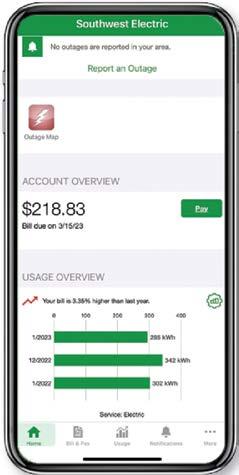










Southwest Electric is here to serve our Members with electricity to power homes and businesses. This section will introduce you to the employees who make that happen every day.
First, we would like for you to meet our cashiers, Latarsha Wells-Brown (left) and Dorothy Smith (right). These are the first friendly faces many of our Members see when they come to the Lorman o ce. The cashiers are in the Accounting Department. They take payments, answer questions about bills, explain procedures and open the large quantity of mail. After a major storm when we have power outages, they assist the Member Services Representatives with calls from Members.







Locked gates prohibit maintenance, delay power restoration and increase expenses when return trips are required. Make sure Southwest Electric has your gate code noted on your account to ensure we can access our equipment 24/7. Alternatively, we can provide you with a special padlock to which only Southwest Electric personnel have a key. To provide your gate code or request a lock, call us at 800-287-8564 or 601-437-3611.


















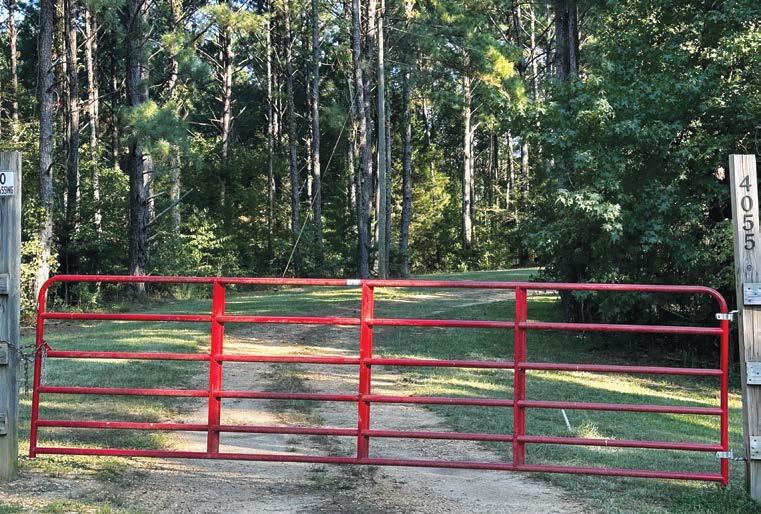


























Modern farming often relies on data and equipment with GPS and auto-guidance systems. Even with these modern conveniences, farm workers must remain vigilant. That’s because farming is considered one of the most dangerous jobs.
Massive machinery is indispensable to farming, but the same impressive size, height, and extensions make them particularly vulnerable to contacting power lines. That’s why staying alert, focused, and knowledgeable about potential hazards and safety procedures is crucial.
During a busy harvest season, the familiar sights around the farm can easily fade into the background, and farm workers can overlook the power lines overhead. However, failing to notice them can lead to deadly accidents.
Awareness of your surroundings, around, above, and below, and planning safe equipment routes can significantly reduce the risk of










accidents. Even with GPS and auto-steering, it’s imperative that farm workers keep a close eye on the equipment’s location and are ready to take action if necessary.
Exposed underground powerlines, defective wiring in farm buildings, and extension cords are also hazards. Grain bins can pose a potential danger as well. The National Electrical Safety Code requires power lines to be at least 18 feet above the highest point on any grain bin with which portable augers or other portable filling equipment are used. If you plan to install new grain bins or you’re concerned about the proximity of power lines to existing grain bins, contact Twin County Electric.

General Manager by Leslie Holloway










• Exercise caution near power lines. Be careful when raising augers or the bed of grain trucks around power lines.



• Use spotters when operating large machinery near power lines. Ensure the spotters do not touch the machinery while it is moving near power lines.




• Lower equipment extensions, portable augers, or elevators before moving or transporting equipment. Do not raise equipment, such as ladders, poles, or rods into power lines. Remember that non-metallic materials like lumber, tree limbs, ropes, and hay can conduct electricity, especially when damp, dusty, or dirty.
• Never attempt to raise or move power lines to clear a path. Doing so could result in electric shock or death.




• Avoid using metal poles inside bins. Don’t use metal poles to break up bridged grain inside or around bins.
• Hire qualified electricians. Ensure that qualified electricians handle work















Twin County’s Annual Meeting of Members will be held on Sept. 17, 2024, beginning at 1:30 p.m. Registration will begin at 12:30 p.m. The meeting location will be at Twin County’s Conference Center at 898 East Avenue North in Hollandale. Twin County members in good standing as of the Record date, July 16, 2024, will be allowed to vote at the meeting either in person or by proxy. A formal notice of Annual Meeting and a Proxy was mailed to Twin County’s Members in good standing as of the Record Date. To designate a proxy, you must use the form provided by Twin County. The form must be signed by the Member whose name appears on the Proxy and delivered in person to one of Twin County’s o ces in Hollandale, Belzoni, Rolling Fork, or Greenville. Proxies will also be accepted by mail in the self-addressed envelope provided by Twin County. ALL PROXIES MUST BE RECEIVED BY 5PM ON SEPTEMBER 11, 2024.
The following members have met the qualifications and have been nominated as candidates for directors pursuant to Twin County’s By-Laws: Timothy A. Clements, 1 Orchard Place, Greenville, MS 38701 (currently serving as Director of Twin County – Greenville Service Area); Bryan E. Thomas, 2668 VFW Road, Leland, MS 38756 (currently serving as Director of Twin County – Greenville Service Area); Norma C. Quinn, 114 Van Buren, Belzoni, MS 39038 (currently serving as Director of Twin County – Belzoni Service Area).




At the annual meeting the members will take action upon the following matters: (1) the reports of O cers, Directors, and Committees; (2) the election of Directors in eligible service areas; and (3) any and all other business which may legally come before the meeting, or any adjournment or adjournments thereof.








Mark your calendar for Sept. 17, 2024, for Twin County’s Annual Meeting of Members beginning at 1:30 p.m. at the Twin County Conference Center at 898 East Avenue North in Hollandale. Registration begins at 12:30 p.m.

Twin County will select four winners to each receive $100 credit on their Twin County account. Winners will be selected from Members attending the annual meeting or from Member proxies mailed or hand delivered by the Member to one of Twin County’s o ces by the deadline of Sept. 11 at 5 p.m.









by Scott Flood
From grocery store shelves to repair parts for vehicles, we’ve all had firsthand experiences with supply chain issues in recent years. So much so that the supply chain has become a convenient scapegoat anytime a business falls short of our expectations. But when it comes to your local electric cooperative, supply chain challenges are very real and often troubling.
Parts and components electric co-ops use every day are in short supply, which delays planned upgrades for power reliability and increases the costs of parts and labor.
Electric co-ops are working together to find innovative ways to deal with supply chain issues. This year, those e orts resulted in a major win regarding updated federal e ciency standards for distribution transformers that has co-op leaders breathing more easily.
Electric transformers are critical pieces of equipment that help deliver power to consumers. These essential devices adjust electricity voltage, either up or down, to enable safe and e cient power flow.
a time when transformer manufacturers are already struggling to keep up with demand. Currently, there is only one U.S. producer of this specialty steel.
The availability of federal infrastructure funding is making it possible for co-ops to invest in the capacity, safety, and reliability of the systems delivering electricity to co-op communities. That’s a good thing for coops and their members, but it’s increasing pressure on the supply chain.
“The domestic supply chain hasn’t caught up with demand, and the industry is going through a learning curve,” notes Stephanie Crawford, NRECA regulatory a airs director. “It’s going to take some time for manufacturers to retool their production and producers to make enough amorphous steel to meet the need.”
While co-op leaders appreciate the significant amount of federal money being made available to update local energy infrastructure, that’s also putting the squeeze on supply.







Late in 2022, the Department of Energy (DOE) proposed new e ciency requirements for the distribution transformers that deliver power to every home, school, and business in America. Among other provisions, the proposal would have required manufacturers of those transformers switch to amorphous steel within three years, in place of the grain oriented electrical steel (GOES) that has long been used. Amorphous steel is chemically altered in ways that may make transformers more e cient.
The National Rural Electric Cooperative Association (NRECA), the national trade association that represents more than 900 co-ops, is wary of DOE’s expectations for this change in material, and especially at
“Everyone across the country is making these investments at the same time, creating demand not just for new transformers, but for all the basic materials and equipment cooperatives need,” Crawford adds. “Amid all the challenges co-ops are already facing, it presents a big problem to ask the industry to make a 100% switch in just three years when the sole supplier only produces enough for about 5% of today’s market.”
NRECA and electric co-ops joined others in the power industry to educate key contacts in Congress, the White House, and DOE about supply chain challenges, particularly the requirements for the quick shift to amorphous steel.
“After more than a year of advocacy e orts, the DOE issued its final rule, which allows continued use of GOES in smaller-sized transformers,” Crawford explains. “This provides greater certainty with the transformer sizes cooperatives use the most, particularly in the residential segment.”
The DOE rule also includes a longer compliance timeframe for shifting to amorphous steel.
“Extending the deadline to 2029 will help manufacturers adapt for the future,” Crawford said. “The extension allows transformer manufacturers more time to adjust to the new standard and focus on output that electric cooperatives need.”
For the foreseeable future, electric co-ops will continue to face challenges in securing the supplies and equipment they need. The good news is that most have initiated processes to mitigate and manage those risks, so they can continue to meet their members’ needs. While the future availability of larger transformers remains a cause for concern, co-ops are pleased to see investments in U.S. manufacturing facilities, and that’s a hopeful sign.












































by Miranda Boutelle
QHow do I use federal tax credits and rebates to upgrade my home?
ATax credits and rebates can help bridge the a ordability gap to higher e ciency equipment for your home, allowing you to complete energy e ciency upgrades that can lower your energy use and save you money in years to come.
First, knowing the di erence between a tax credit and rebate is important. A rebate is a payment for purchasing or installing a qualified product or home improvement. Depending on how the rebate program is set up, it may be provided at the time of purchase or applied for and received after installation. Check with your electric cooperative to see if they o er rebates. Typically, the rebate is applied as a credit on your electric bill. In some cases, the rebate is provided as a cash payment to those who complete eligible projects.
A tax credit is a dollar-for-dollar amount that taxpayers can report on their tax documents to reduce the amount of taxes owed. You apply for a tax credit when you file your tax documents, so it typically takes longer to reap the benefits than it does with a rebate.
According to ENERGY STAR®, homeowners can qualify for up to $3,200 annually in federal tax credits for energy e ciency upgrades. Federal tax credits are available for heating and cooling system upgrades, including heat pumps, furnaces, central air conditioners, boilers, and geothermal heat pumps. Tax credits for ENERGY STAR®-rated heat pump water heaters cover 30% of the project cost, up to $2,000. You can also improve your home’s envelope — the portion of the home that separates the inside from the outside — with tax credits for insulation, windows and skylights.
If an energy e ciency upgrade requires improving the electrical panel in your home, there’s a tax credit for that, too. You can receive 30% of the cost of the panel upgrade, up to $600.
These federal tax credits are available through 2032. You must own the home you’re upgrading, and it must be your primary residence. Federal tax credits only apply to existing homes in the United States, not new construction.
The Inflation Reduction Act of 2022 expanded available funding for many home upgrades. The act allocated $8.8 million for home rebate programs to be implemented at the state level, and this funding is o ered in two di erent programs. The HOMES program allows up to $8,000 per home for standard-income households. Higher rebates are available for low- to moderate-income households. The HEAR program o ers rebates of up to $14,000 per home for qualified, e cient electric equipment for low- to moderate-income households.
These programs are designed to bolster existing programs and should be available in late 2024 or early 2025. Check with your electric cooperative or state o ce to find out if they are being o ered in your state.

When shopping for appliances, look for the ENERGY STAR® logo on the energy guide to identify which products are the most e cient options.

Tax credits for ENERGY STAR® heat pump water heaters cover 30% of the project cost, up to $2,000.
Additional energy e ciency rebates might also be available. More than half of U.S. states require energy e ciency programs for residents, according to the American Council for an EnergyE cient Economy. These programs can help people save money on their electric bills and help states meet climate goals, reduce system costs, and improve the electric grid.
I have had the privilege of working in energy e ciency rebate programs for many years and have seen the benefits of these programs firsthand. Tax credit and rebate programs can make upgrades more a ordable — helping people save money and improve the overall comfort of their homes.
Miranda Boutelle is the chief operating o cer at E ciency Services Group in Oregon, a cooperatively owned energy e ciency company.


























The Annual Meeting of Members of Yazoo Valley Electric Power Association will be held Tuesday, Nov. 12, 2024, at 1 p.m. at the o ce of the Association in Yazoo City.
At this meeting, two directors will be elected to serve a three-year term each. Of the two directors to be elected, one must be a Yazoo Valley member and resident of Yazoo, Holmes or Humphreys County. The other director must be a Yazoo Valley member and resident of Yazoo, Holmes, Humphreys, Warren, Sharkey, or Issaquena County. A committee to consider and make nominations for directors of the Association was appointed at an August meeting of the board of directors. Members appointed to serve on this committee are Houston Cohea, James T. Henry, Will Jones, Dianne Lewis, Jamie Peaster, Tim Trammell, Mary Tucker, and Rosemary Watson.
The Committee will meet at a time and place set by the board of directors and shall prepare and post a list of nominations for board



members at the main o ce of the Association at least 30 days before the annual meeting. Any 50 members acting together may make other nominations by petition, and the Secretary shall post such nominations at the same place where the list of nominations by the Committee is posted. Nominations made by petition, to be e ective, must be received by the Association at least 10 days before the meeting.
At least 30 days before the date of the annual meeting, each member will receive a notice stating the place, day and hour of the meeting. Such notice will include the number of directors to be elected and the names and addresses of the candidates nominated by the committee on nominations.
At the annual meeting, a report will be made to the members on the operation of the Association for the past year, and all business coming before the meeting will be transacted.

NOVEMBER 12



Mark y r calendar for NOV. 12, 2024
Mark your calendar for Nov. 12, 2024, for Yazoo Valley’s Annual Meeting of Members beginning at 1 p.m. at the Yazoo Valley Electric Power Association o ce at 2255 Gordon Avenue in Yazoo City. Registration begins at 12 p.m.















by Scott Flood

From grocery store shelves to repair parts for vehicles, we’ve all had firsthand experiences with supply chain issues in recent years. So much so that the supply chain has become a convenient scapegoat anytime a business falls short of our expectations. But when it comes to your local electric cooperative, supply chain challenges are very real and often troubling.
Parts and components electric co-ops use every day are in short supply, which delays planned upgrades for power reliability and increases the costs of parts and labor.
Electric co-ops are working together to find innovative ways to deal with supply chain issues. This year, those e orts resulted in a major win regarding updated federal e ciency standards for distribution transformers that has co-op leaders breathing more easily.
Electric transformers are critical pieces of equipment that help deliver power to consumers. These essential devices adjust electricity voltage, either up or down, to enable safe and e cient power flow.
Late in 2022, the Department of Energy (DOE) proposed new



e ciency requirements for the distribution transformers that deliver power to every home, school, and business in America. Among other provisions, the proposal would have required manufacturers of those transformers switch to amorphous steel within three years, in place of the grain oriented electrical steel (GOES) that has long been used. Amorphous steel is chemically altered in ways that may make transformers more e cient.
The National Rural Electric Cooperative Association (NRECA), the national trade association that represents more than 900 co-ops, is wary of DOE’s expectations for this change in material, and especially at a time when transformer manufacturers are already struggling to keep up with demand. Currently, there is only one U.S. producer of this specialty steel.
The availability of federal infrastructure funding is making it possible for co-ops to invest in the capacity, safety, and reliability of the systems delivering electricity to co-op communities. That’s a good thing for coops and their members, but it’s increasing pressure on the supply chain.
“The domestic supply chain hasn’t caught up with demand, and the industry is going through a learning curve,” notes Stephanie Crawford, NRECA regulatory a airs director. “It’s going to take some time for manufacturers to retool their production and producers to make enough amorphous steel to meet the need.”
While co-op leaders appreciate the significant amount of federal money being made available to update local energy infrastructure, that’s also putting the squeeze on supply.
Everyone across the country is making these investments at the same time, creating demand not just for new transformers, but for all the basic materials and equipment cooperatives need.
“Everyone across the country is making these investments at the same time, creating demand not just for new transformers, but for all the basic materials and equipment cooperatives need,” Crawford adds. “Amid all the challenges co-ops are already facing, it presents a big problem to ask the industry to make a 100% switch in just three years when the sole supplier only produces enough for about 5% of today’s market.”
NRECA and electric co-ops joined others in the power industry to educate key contacts in Congress, the White House, and DOE about supply chain challenges, particularly the requirements for the quick shift to amorphous steel.


“After more than a year of advocacy e orts, the DOE issued its final rule, which allows continued use of GOES in smaller-sized transformers,” Crawford explains. “This provides greater certainty with the transformer sizes cooperatives use the most, particularly in the residential segment.”
The DOE rule also includes a longer compliance timeframe for shifting to amorphous steel.
“Extending the deadline to 2029 will help manufacturers adapt for the future,” Crawford said. “The extension allows transformer manufacturers more time to adjust to the new standard and focus on output that electric cooperatives need.”
For the foreseeable future, electric co-ops will continue to face challenges in securing the supplies and equipment they need. The good news is that most have initiated processes to mitigate and manage those risks, so they can continue to meet their members’ needs. While the future availability of larger transformers remains a cause for concern, co-ops are pleased to see investments in U.S. manufacturing facilities, and that’s a hopeful sign.









For more than four decades, business writer Scott Flood has worked with electric cooperatives to build knowledge of energy-related issues among directors, sta , and members.












































by Miranda Boutelle
QHow do I use federal tax credits and rebates to upgrade my home?
ATax credits and rebates can help bridge the a ordability gap to higher e ciency equipment for your home, allowing you to complete energy e ciency upgrades that can lower your energy use and save you money in years to come.
First, knowing the di erence between a tax credit and a rebate is important. A rebate is a payment for purchasing or installing a qualified product or home improvement. Depending on how the rebate program is set up, it may be provided at the time of purchase or applied for and received after installation. Check with your electric cooperative to see if they o er rebates. Typically, the rebate is applied as a credit on your electric bill. In some cases, the rebate is provided as a cash payment to those who complete eligible projects.
A tax credit is a dollar-for-dollar amount that taxpayers can report on their tax documents to reduce the amount of taxes owed. You apply for a tax credit when you file your tax documents, so it typically takes longer to reap the benefits than it does with a rebate.
According to ENERGY STAR®, homeowners can qualify for up to $3,200 annually in federal tax credits for energy e ciency upgrades. Federal tax credits are available for heating and cooling system upgrades, including heat pumps, furnaces, central air conditioners, boilers, and geothermal heat pumps. Tax credits for ENERGY STAR®-rated heat pump water heaters cover 30% of the project cost, up to $2,000. You can also improve your home’s envelope — the portion of the home that separates the inside from the outside — with tax credits for insulation, windows and skylights.
If an energy e ciency upgrade requires improving the electrical panel in your home, there’s a tax credit for that, too. You can receive 30% of the cost of the panel upgrade, up to $600.
These federal tax credits are available through 2032. You must own the home you’re upgrading, and it must be your primary residence. Federal tax credits only apply to existing homes in the United States, not new construction.
The Inflation Reduction Act of 2022 expanded available funding for many home upgrades. The act allocated $8.8 million for home rebate programs to be implemented at the state level, and this funding is o ered in two di erent programs. The HOMES program allows up to $8,000 per home for standard-income households. Higher rebates are available for low- to moderate-income households. The HEAR program o ers rebates of up to $14,000 per home for qualified, e cient electric equipment for low- to moderate-income households.
These programs are designed to bolster existing programs and should be available in late 2024 or early 2025. Check with your electric cooperative or state o ce to find out if they are being o ered in your state.

When shopping for appliances, look for the ENERGY STAR® logo on the energy guide to identify which products are the most e cient options.

Tax credits for ENERGY STAR® heat pump water heaters cover 30% of the project cost, up to $2,000.
Additional energy e ciency rebates might also be available. More than half of U.S. states require energy e ciency programs for residents, according to the American Council for an EnergyE cient Economy. These programs can help people save money on their electric bills and help states meet climate goals, reduce system costs, and improve the electric grid.
I have had the privilege of working in energy e ciency rebate programs for many years and have seen the benefits of these programs firsthand. Tax credit and rebate programs can make upgrades more a ordable — helping people save money and improve the overall comfort of their homes.
Miranda Boutelle is the chief operating o cer at E ciency Services Group in Oregon, a cooperatively owned energy e ciency company.

Just in case you were living under a rock, this year is an election year.
This is a big one — a presidential election.
It’s not an overstatement to say the decisions made in Washington, D.C. a ect us all.
Election Day is Nov. 5, so we have a few months before we head to the polls.
But September is special because Sept. 17 is National Voter Registration Day.
If you aren’t registered to vote, this month is the perfect time to do just that.
Mississippi’s electric cooperatives want to help members register because it’s important.
Why?
Too often policy decisions made today disproportionately reflect the interests of large utility companies in urban areas. As members and owners of our co-ops, we understand the distinct local challenges we face, and are uniquely responsive to our communities in ways that other utilities are not.
That’s why we need to register to vote and make our voice known.
We need to make sure both our state and federal lawmakers and regulatory o cials understand our unique cooperative needs, so we can continue to provide reliable and a ordable power to our communities.
Many younger people in the state, who are hitting 18 or are a few years older, might not be registered to vote.
To that end, some of our local electrical cooperatives will be stationed at community colleges to get those folks registered. The future belongs to all of us, so we all need to vote to ensure our priorities, values, and perspectives are addressed.
The Sept. 17 voter registration drives are not the only way your electric cooperatives
want to assist members in having a say in the future course of Mississippi.
We want to help members become better informed voters.
Our Co-ops Vote MS initiative and website makes it easier for members to get informed and to participate in the democratic process.
The website — coopsvotems.com — features quick links to important voting information including where to register to vote, our current elected o cials, what elections are occurring this year, and videos of statewide elected o cials talking about the importance of voting, and what they do on a day-to-day basis.
I’ve said this before, and I’m going to say it again. Voting is a form of participation, and every qualified man and woman in Mississippi should not only cast their vote, but care enough to understand who they are voting for and why.
You have the POWER to Register. Be informed. Vote.
On another quick note, this issue is our second annual travel issue. If you’re looking for something to do on a weekend day, hop on The Natchez Trace Parkway and visit one of the many special locations or sites just o this 444-mile jewel.
We hope you enjoy the issue.

by Michael Callahan
Executive Vice President/CEO Electric Cooperatives of Mississippi


Well look at you great, gorgeous Mississippi! Aren’t you significantly something special to see? Varieties of beautiful greens fill spectacular scenery. Oaks, maples, magnolias, pecans, and pines. Shelter and grace three million friends of mine! Then there’s not so cute and cute crazy critters. That Mississippians hunt with hounds, beagles, and sitters. Hogs, coons, gators, does, and deer are about. Good and bad, but not one critter you’d live without. Especially your people, friendly and fair. The best! Occupy your state north, east, south, and west. Land loaded with wandering water, lakes, and streams. Water sports and fisherperson dreams! Yes, God created this mixed combination. Making Mississippi God’s special creation. Due to heavenly Father’s grace. Designed Mississippi as a nearly perfect place. by Tom Morgan, a resident of Sumrall, and a member of Pearl River Valley Electric.
What’s Mississippi to you?
What do you treasure most about life in our state? Send your brief thoughts to Today in Mississippi, news@ecm.coop or mail to P.O. Box 3300, Ridgeland, MS 39158
Submit your beautiful digital photo of life in Mississippi to Today in Mississippi, news@ecm.coop






















